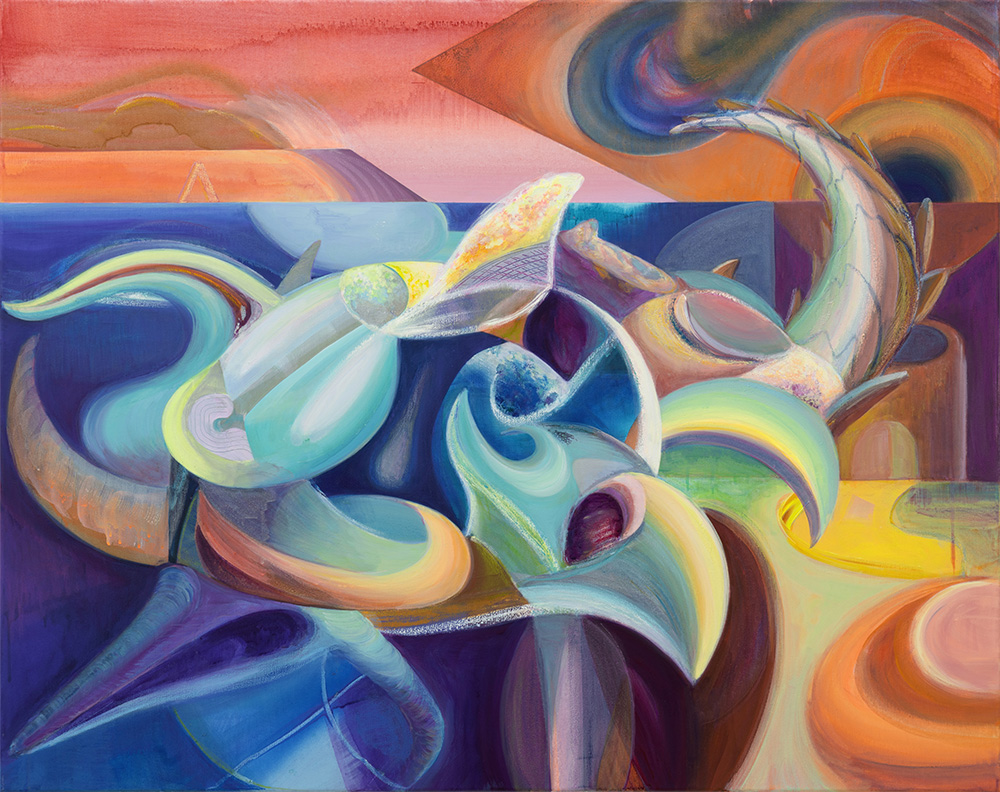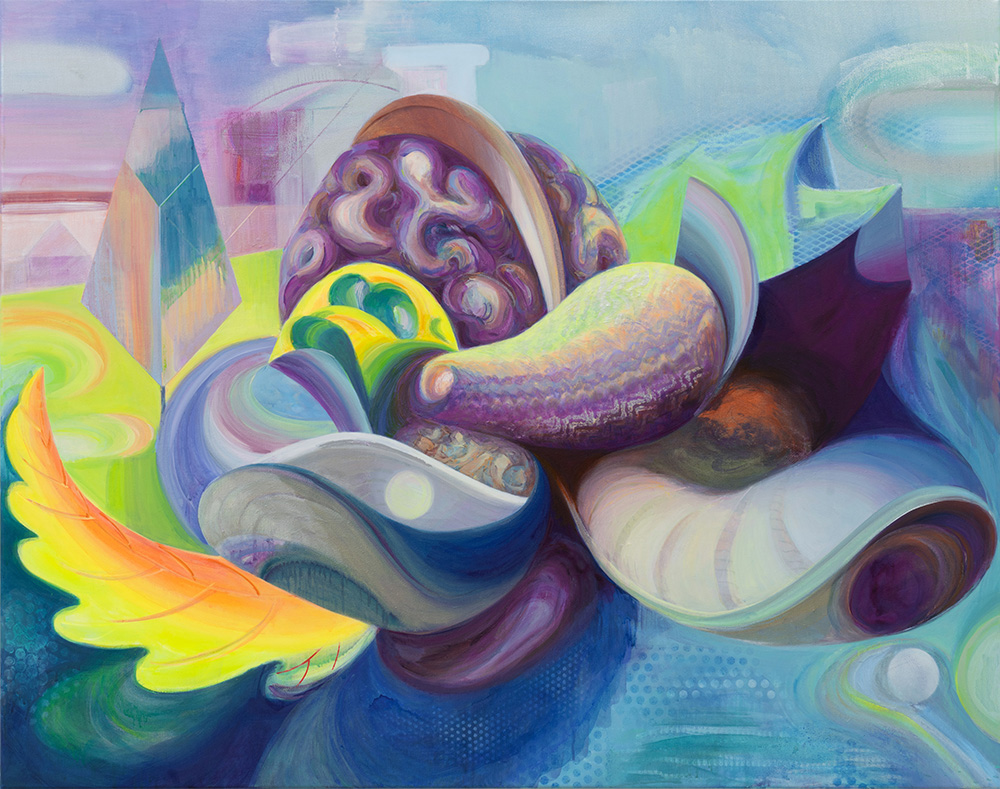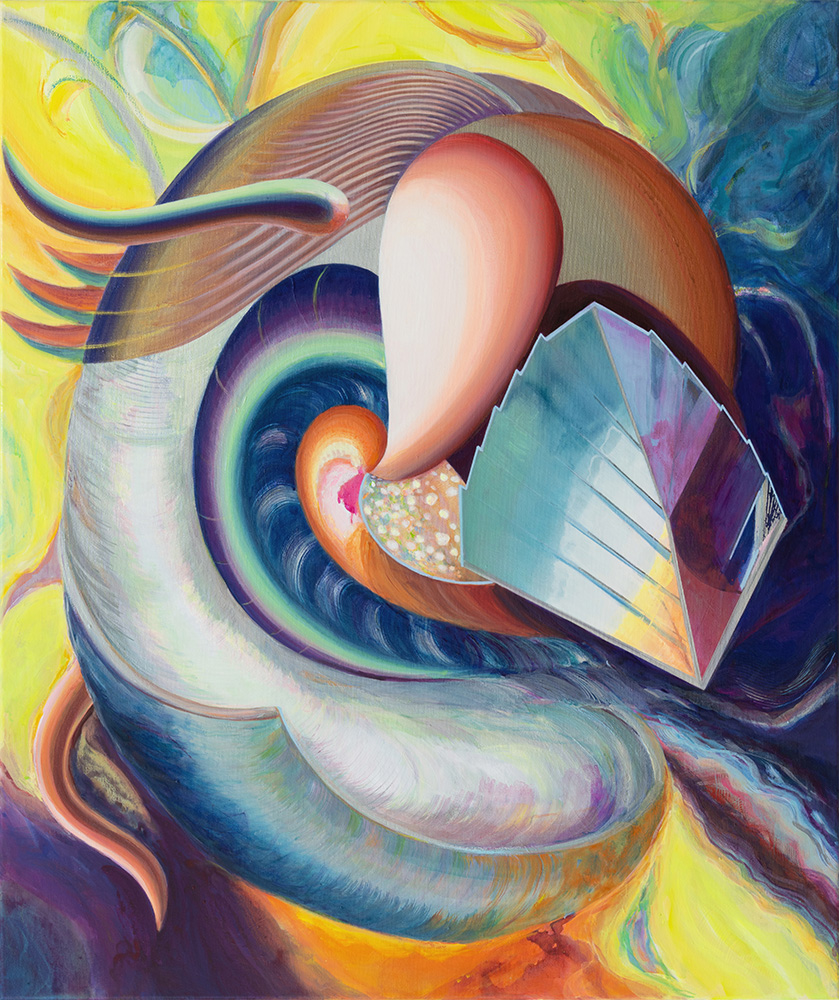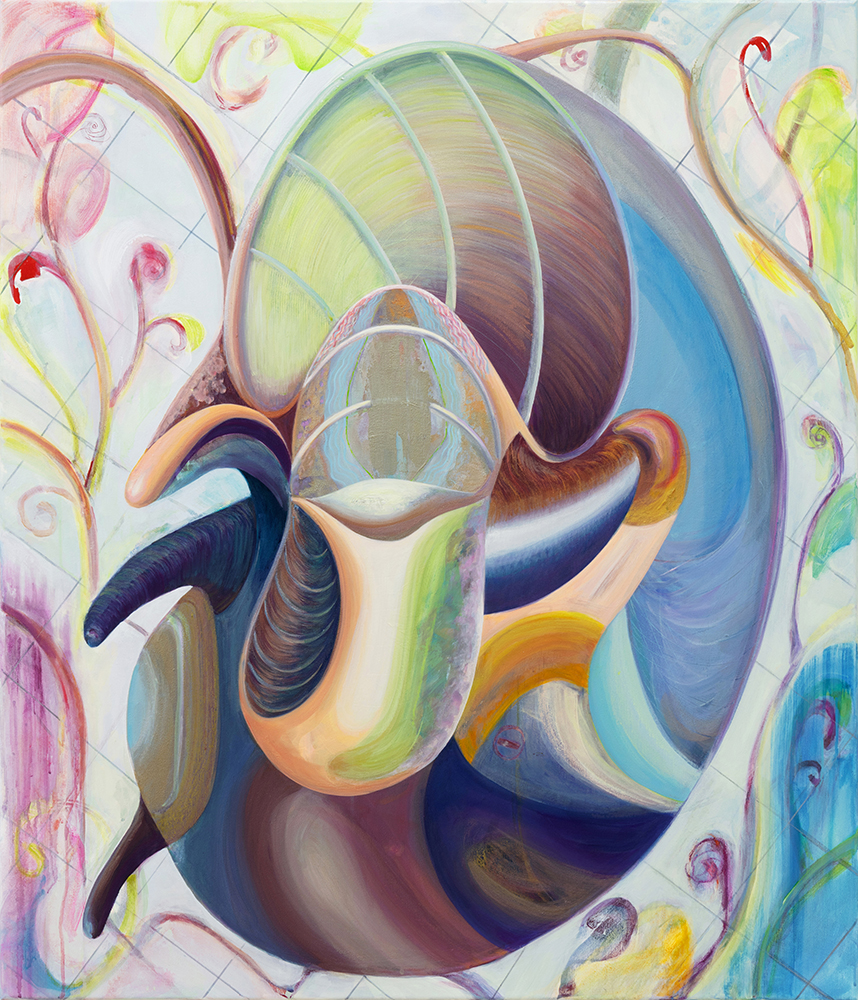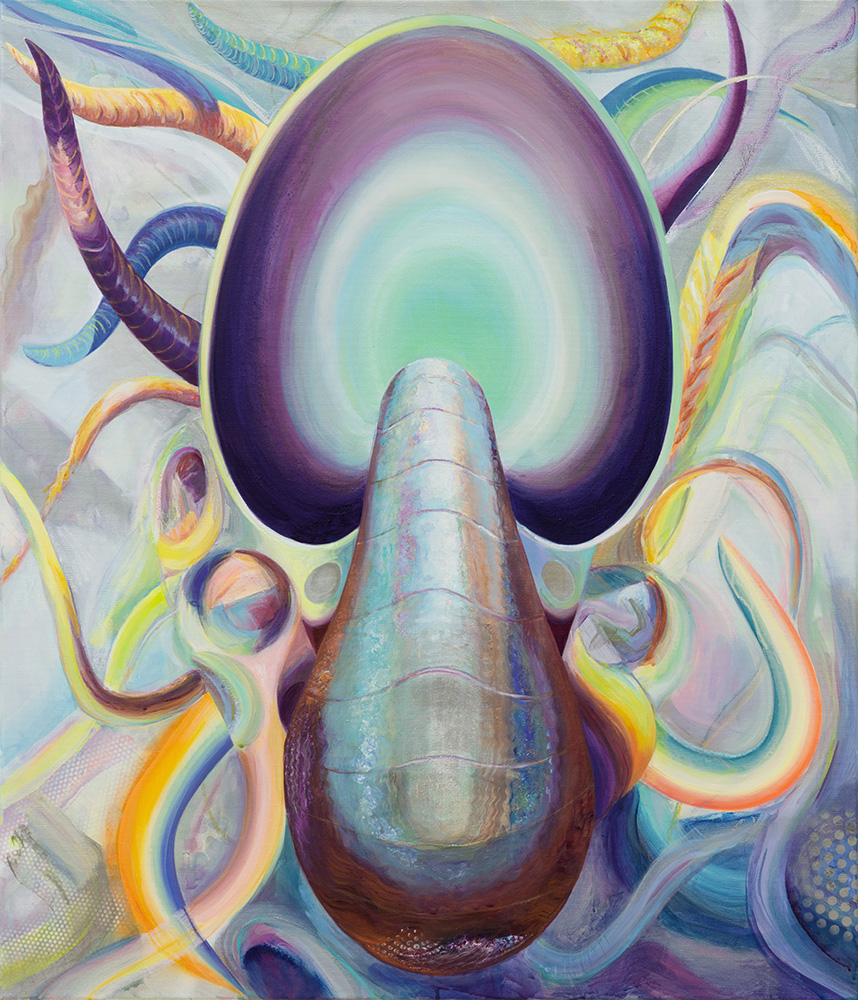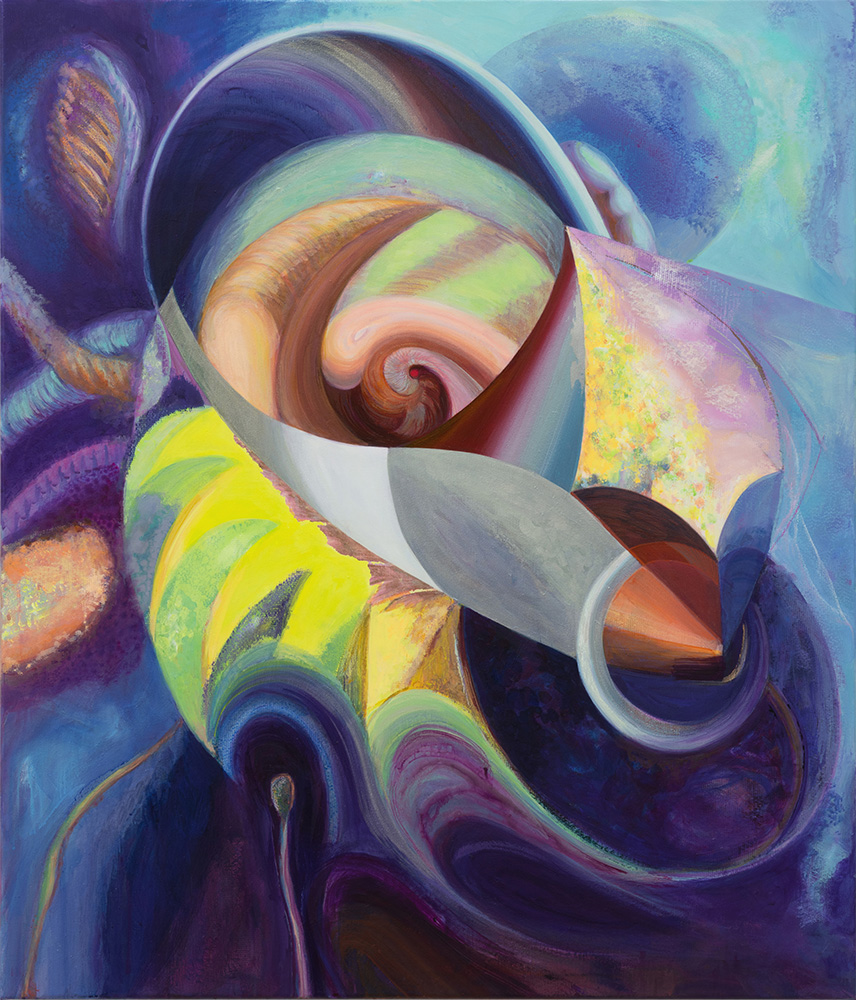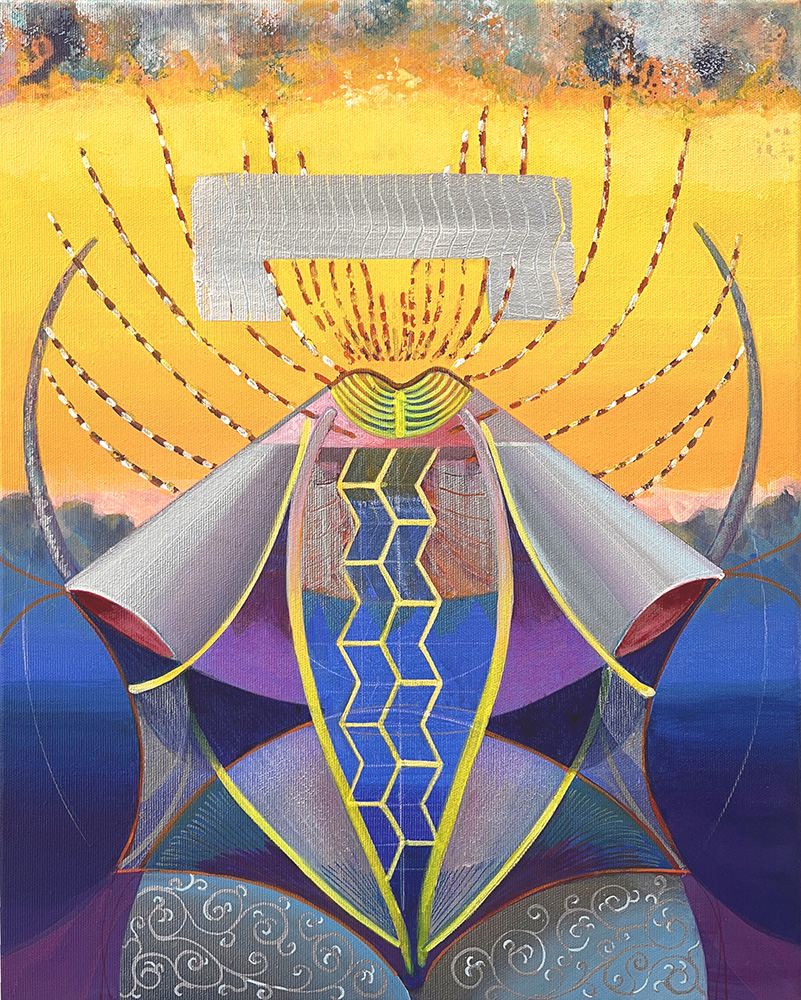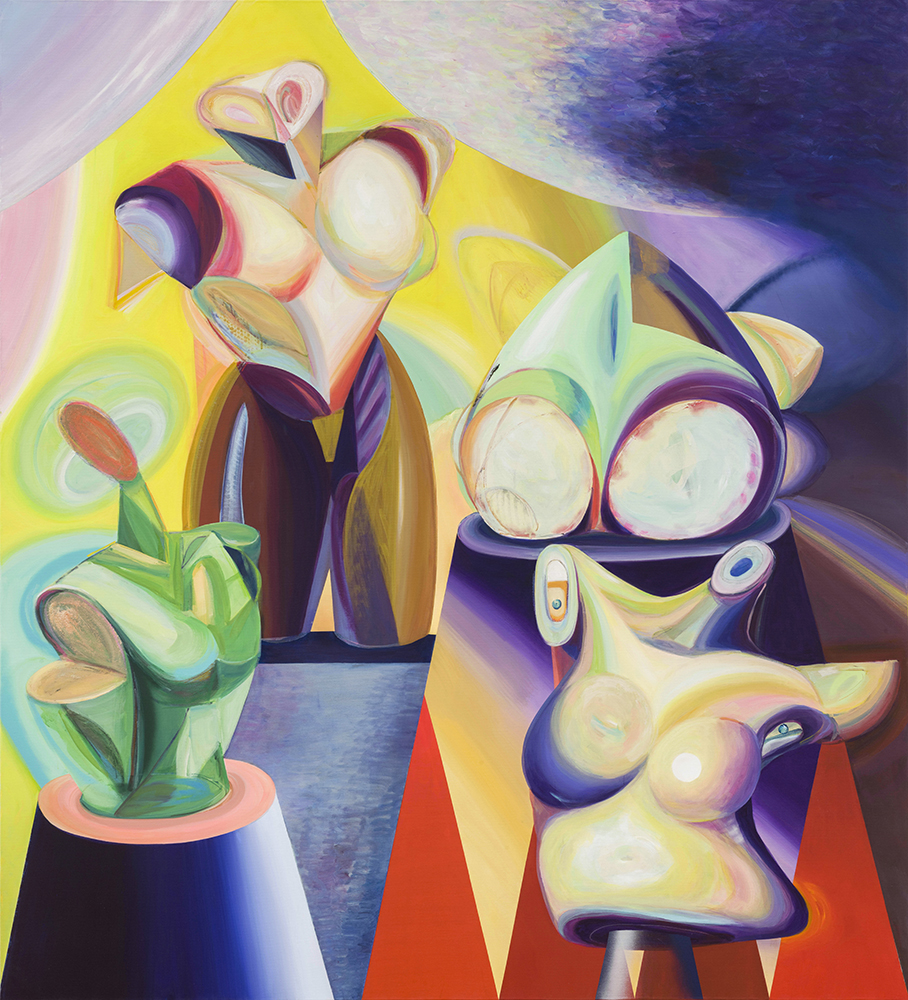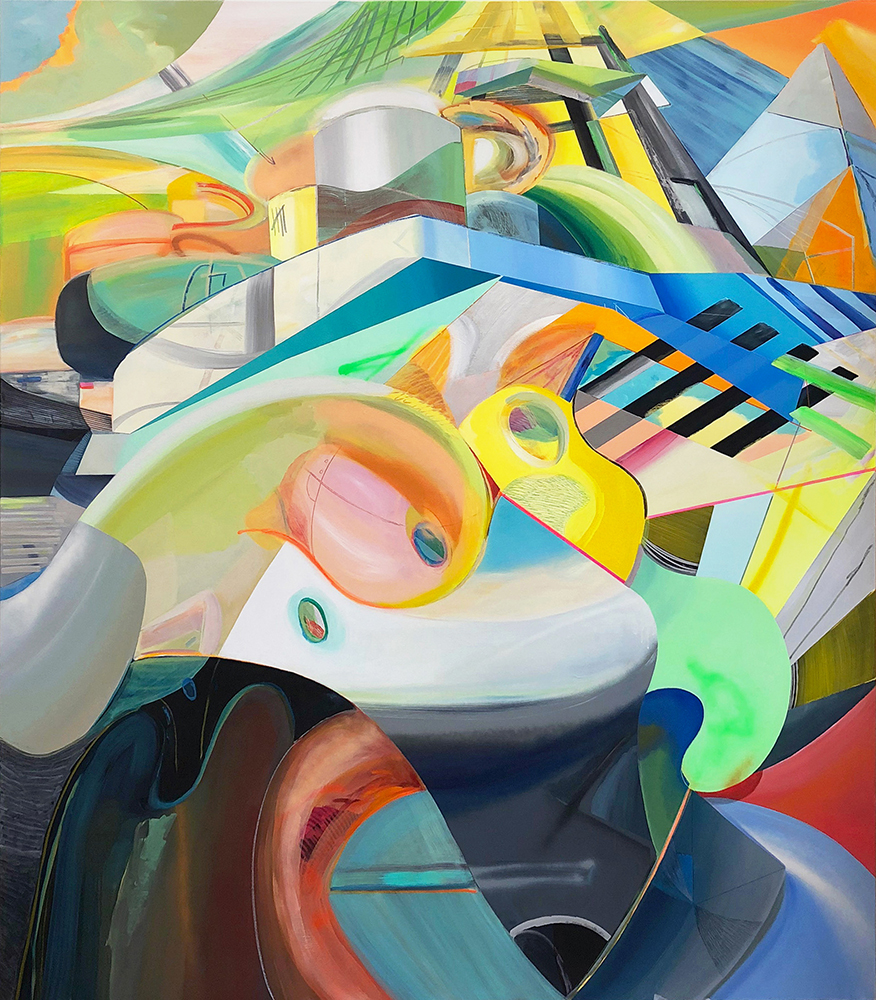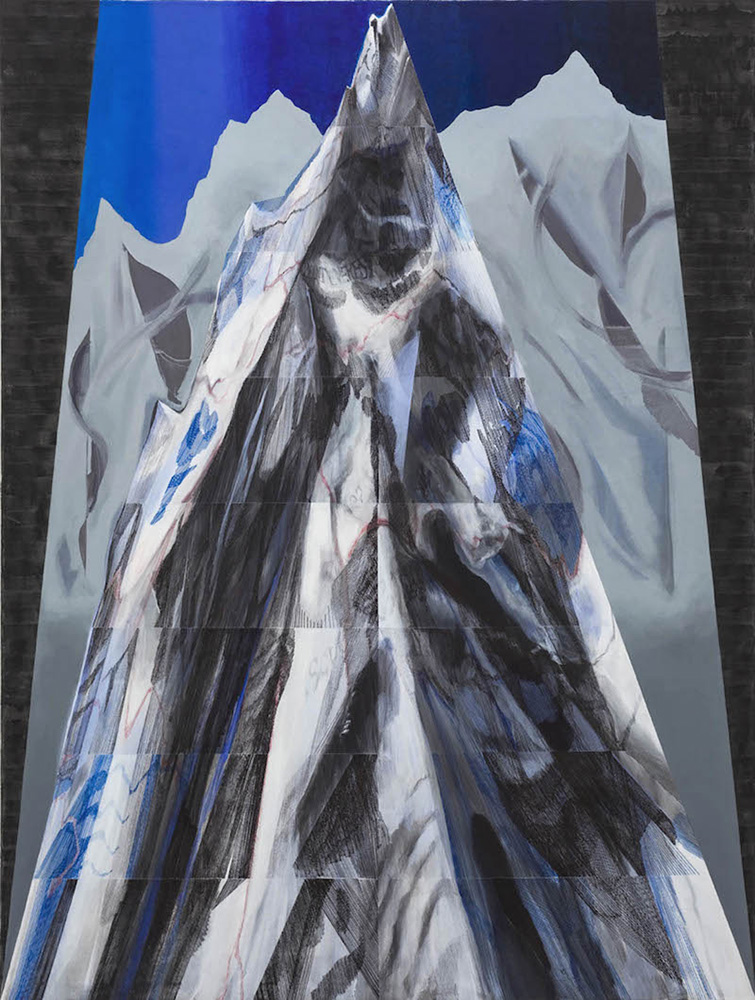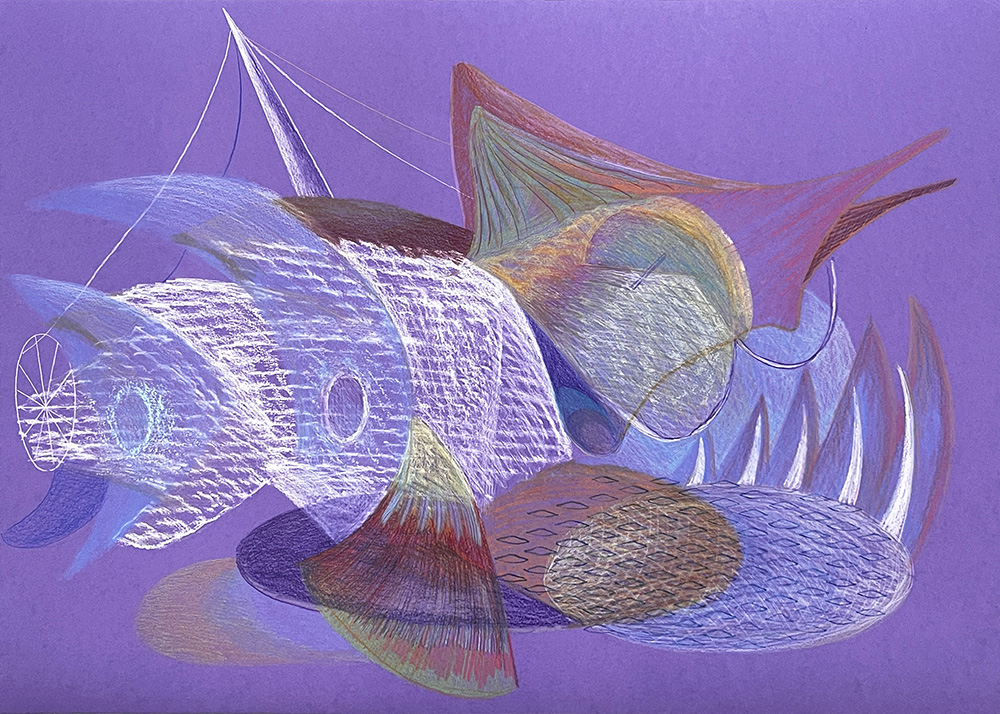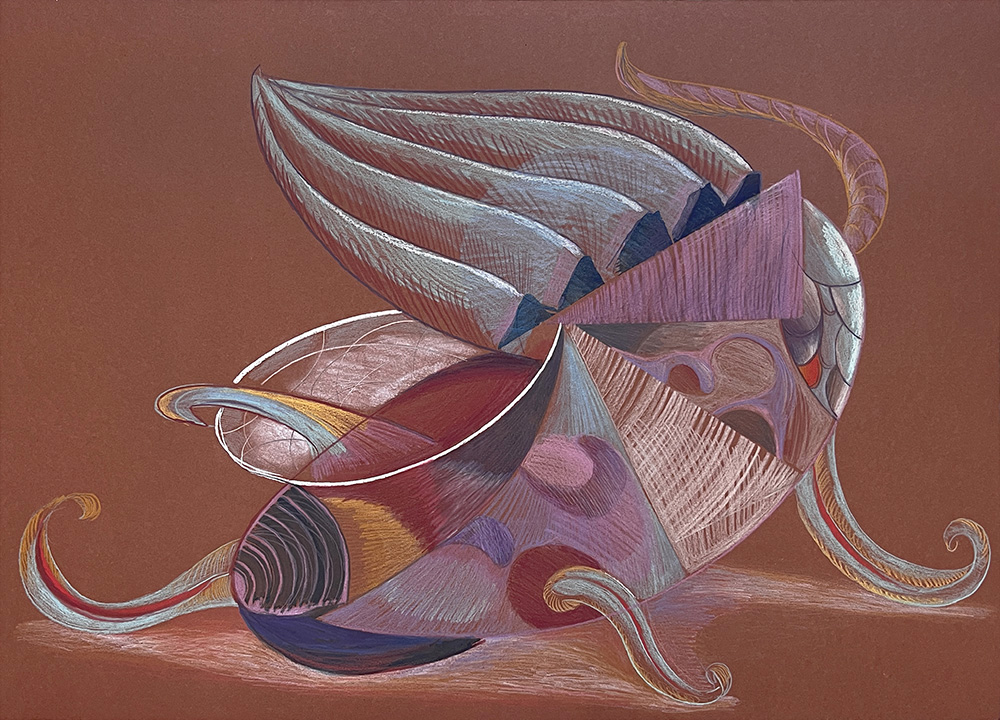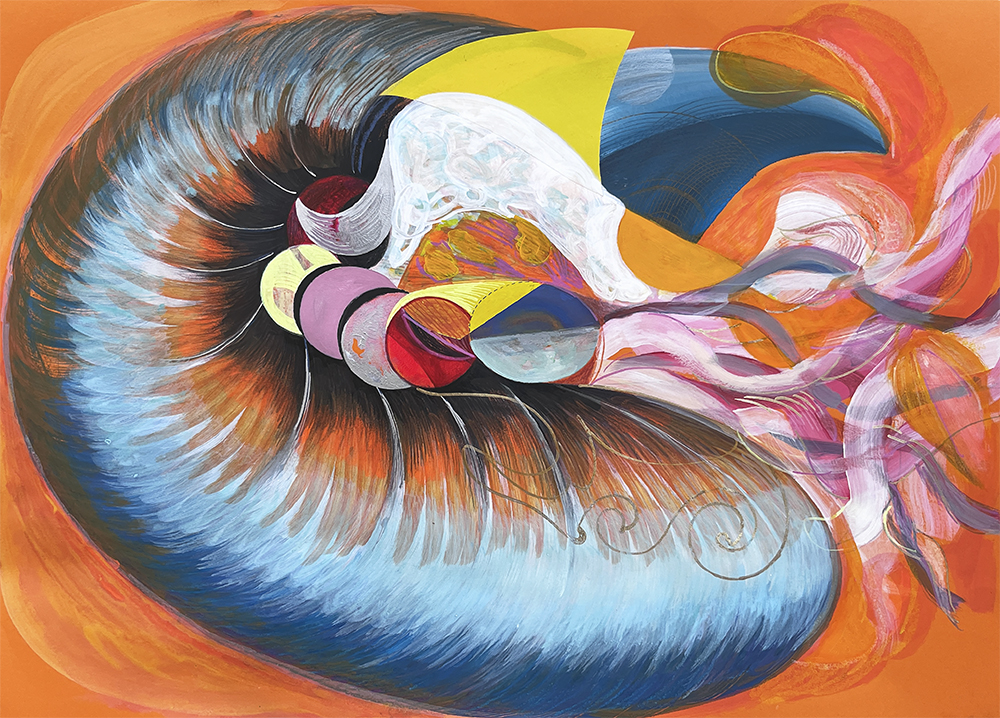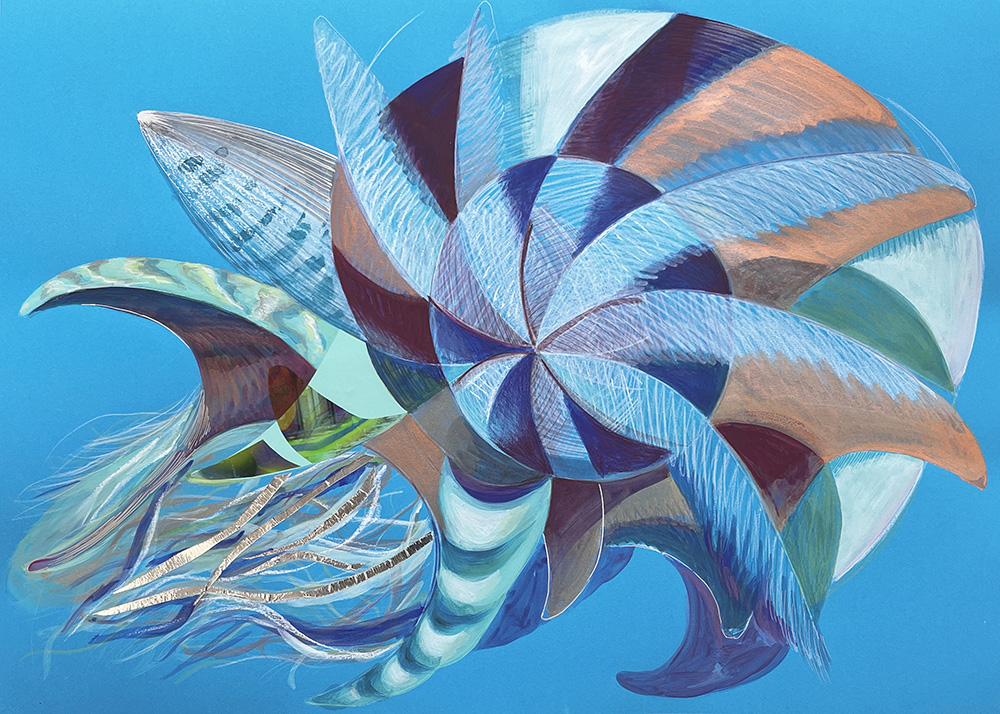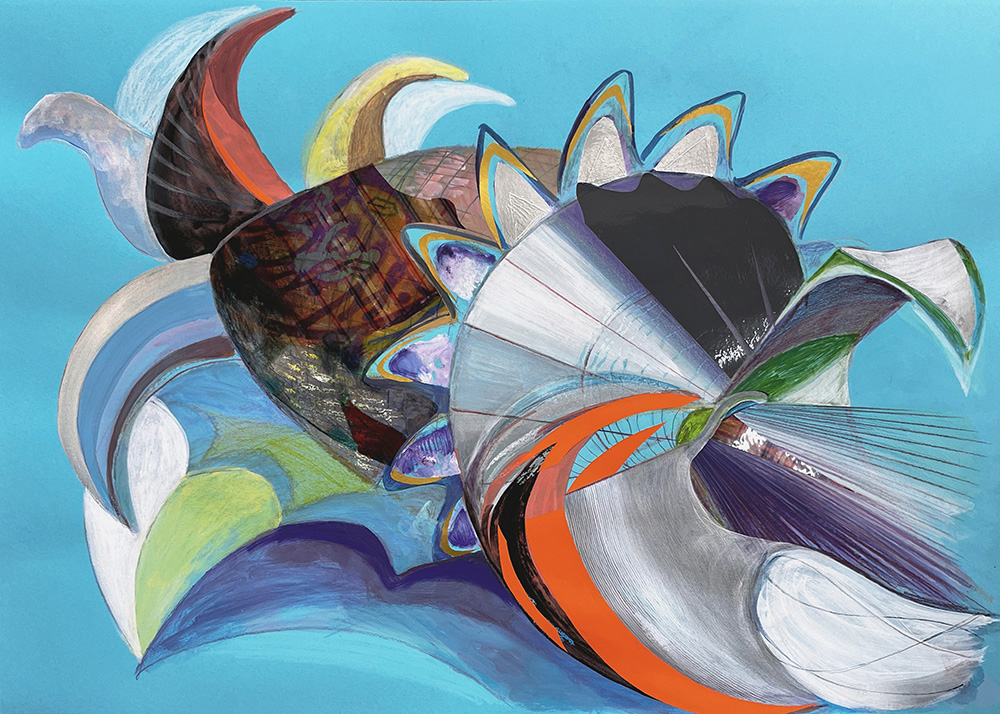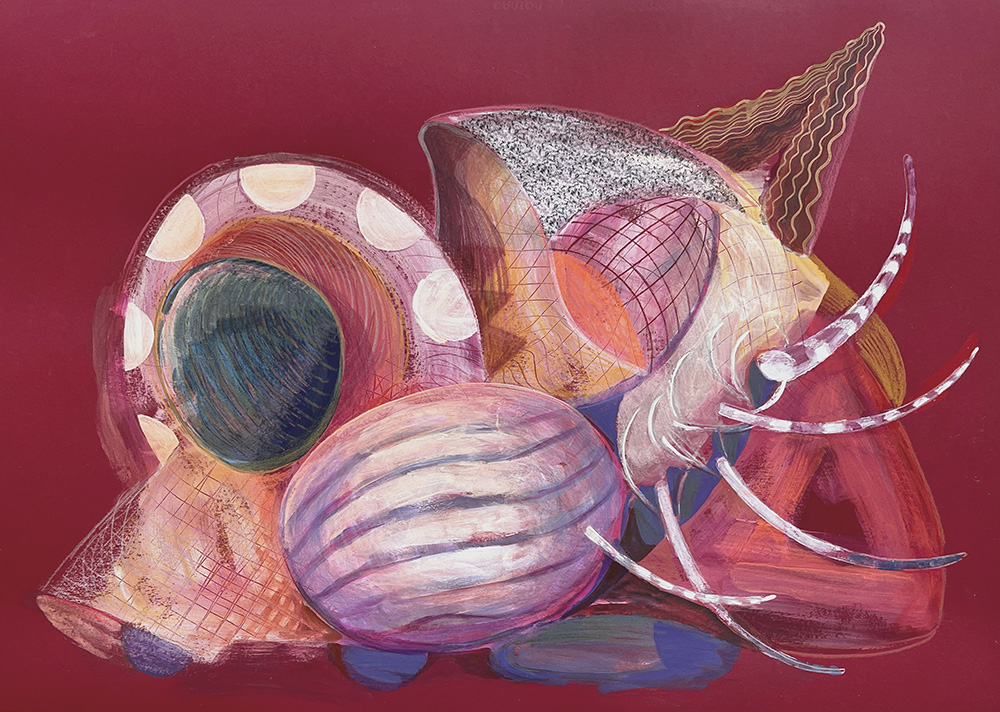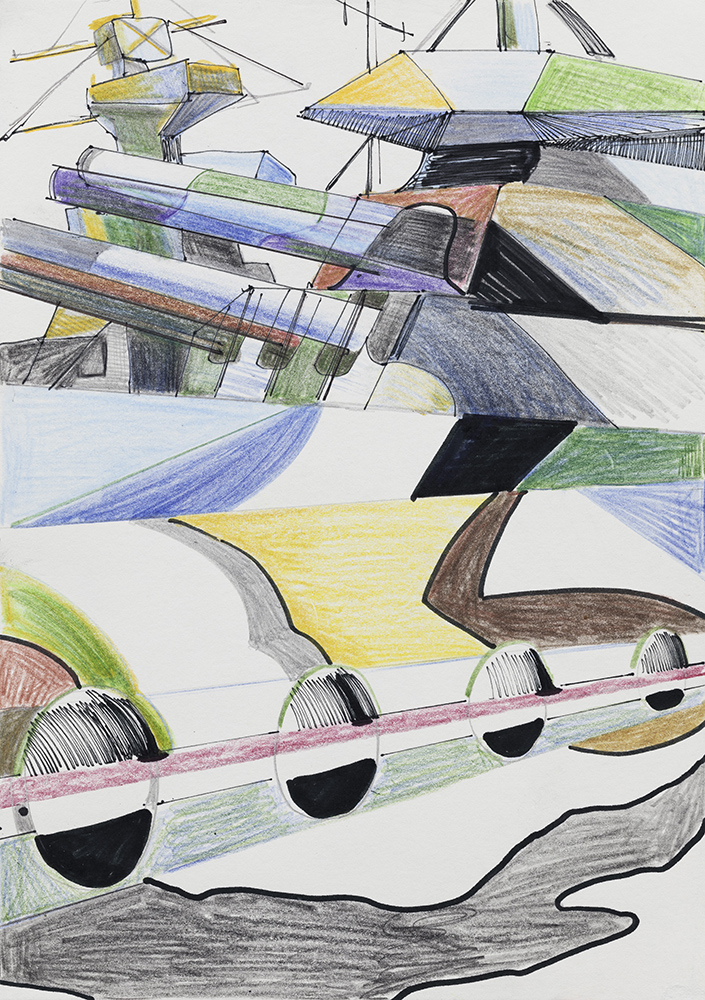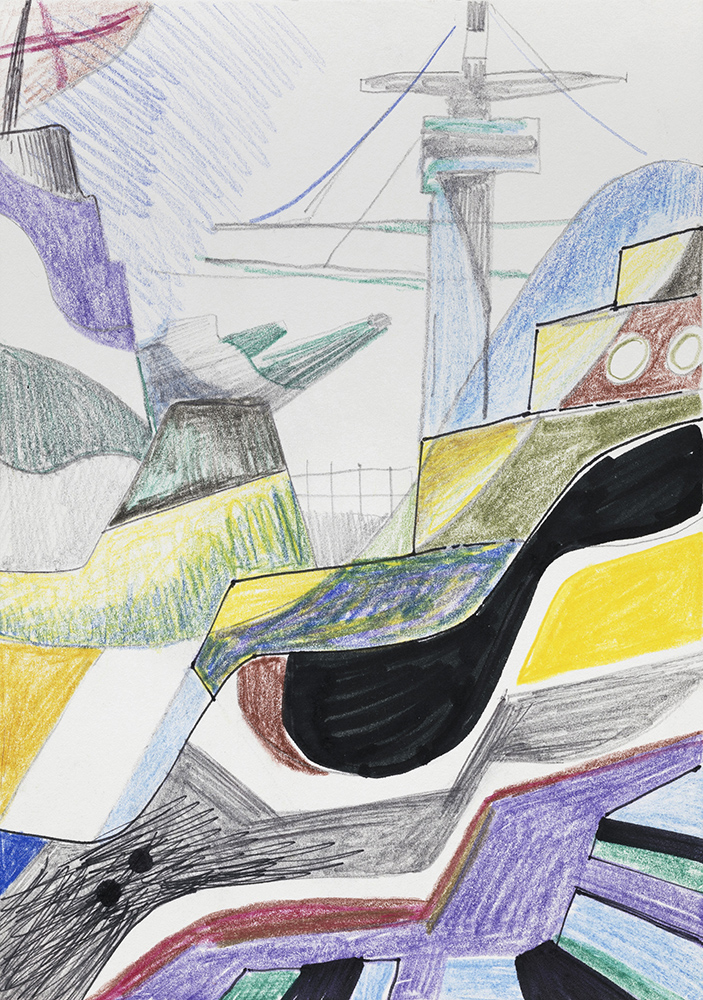2025
acrylic, marker, crayon, oil pastel on canvas
50 x 50 cm
2025
Mother of Pearls
2025
Snail Dreams (4)
2025
acrylic, marker, crayon, oil pastel on canvas
80 x 60 cm
2024
Snail Dreams (1)
2024
acrylic, marker, crayon, oil pastel on canvas
80 x 60 cm
2024
Vessel (2)
2024
acrylic, marker, spray paint, oil pastel on canvas
95 x 120 cm
2024
Nautilus (Portrait)
2024
acrylic, marker, oil pastel on canvas
95 x 80 cm
2024
Nautilus (1)
2024
acrylic, marker, oil stick, oil pastel on canvas
105 x 90 cm
2024
Nautilus (2)
2024
acrylic, marker, spray paint, oil pastel on canvas
105 x 90 cm
2024
Star
2024
acrylic, marker, colored pencil, oil pastel on canvas
90 x 70 cm
2023
Her
2023
acrylic, spray paint, marker, crayon, oil pastel on canvas
250 x 230 cm x 2
__________________
The work is inspired by Scylla, the six-headed sea monster from the Odyssey, who hides in her lair and snatches men from passing ships. In later mythology, she is portrayed as a beautiful nereid who is turned into a monster by a jealous goddess, after Poseidon fell in love with her: Scylla’s genitals and lower body become a mass of mad dogs. In this diptych, the idea of the twisting, swirling man-eater amid the waves is combined with a gigantic ship screw from a modern-day industrial shipyard, which looked like a monumental sculpture with metallic ripples and iridescent scales.
The title refers not only to the female demon, but to the movie ‘Her’ where a bodiless AI voice becomes a real woman in the heart of the male protagonist. The painting turns this immaterial female identity (who is fixated on human interests and only exists through language communication) into its opposite: An overwhelming material being that only exists through physical actions, without any connection to its human prey, like a natural predator.
2023
Sphinx I
2023
acrylic, enamel, marker, crayon, oil pastel on canvas
200 x 160 cm x 2
2023
Sphinx II
2023
acrylic, spray paint, marker, crayon, oil pastel on canvas
200 x 160 cm x 2
2023
Sphinx (9)
2023
acrylic, marker, crayon, oil pastel on canvas
220 x 200 cm
2023
Sphinx (8)
2023
acrylic, marker, crayon, oil pastel on canvas
220 x 200 cm
2023
Red Grass
2023
acrylic, spray paint, marker, oil pastel on canvas
85 x 70 cm
2023
Mermaid
2023
acrylic, marker, colored pencil, oil pastel on canvas
60 x 80 cm
2023
Shell (1)
2023
acrylic, spray paint, marker, oil crayon on canvas
90 x 74 cm
2023
Shell (2)
2023
acrylic, marker, colored pencil, oil crayon on canvas
60 x 80 cm
2022
Hydra
2022-23
acrylic, marker, spray paint, colored pencil, oil pastel on canvas
200 x 160 cm x 3
installation view with stereogram wallpaper
Painting Unsettled, UCCA Edge, Shanghai, 2023
2022
Little Hydra
2022
acrylic and marker on canvas
70 x 90 cm
installation view with stereogram wallpaper
Painting Unsettled, UCCA Edge, Shanghai, 2023
2022
Sphinx (3)
2022
acrylic, spray paint, marker, oil pastel on canvas
220 x 200 cm
2022
Sphinx (2)
2022
acrylic, spray paint, marker, oil pastel on canvas
220 x 200 cm
2022
Sphinx (1)
2022
acrylic, enamel, marker, crayon, oil pastel on canvas
220 x 200 cm
2022
Harpy
2022
acrylic, spray paint, marker, oil pastel on canvas
120 x 200 cm
2022
Sisters (1)
2022
acrylic, marker, oil crayon on canvas
200 x 160 cm
__________________
This series assembles humanoid figures derived from fashion dummies and androids into group portraits, in which their hollow plastic forms are given a sense of autonomy and expression. Set before colorful backdrops that resemble theatrical showcases, the all-female mannequins present static gestures and postures with their standardized composite body parts. The paintings highlight the analogy and contrast between low-tech fashion dummies—as radically simplified, fragmented templates of physical female ‘beauty’—and high-tech humanoid robots, which often appear in the shape of an equally idealized female, animated by AI.
Both kinds of artificial bodies reflect cultural norms and exist to fulfill the purposes ascribed to them by their creators. The story of the lovely and lovable, but superhuman or demonic machine-woman has a long tradition in both Western and Eastern cultures, with tales like those of Pygmalion or E.T.A. Hoffmann’s mechanical puppet Olimpia still resonating in modern cinema, science fiction, and video games. These works aim to give the stage to those mechanical subjects, allowing them a more self-assertive, confrontational performance, while emphasizing their physical presence and individuality through the material skin of painting.
2022
Sisters (2)
2022
acrylic, marker, oil pastel on canvas
200 x 160 cm
__________________
This series assembles humanoid figures derived from fashion dummies and androids into group portraits, in which their hollow plastic forms are given a sense of autonomy and expression. Set before colorful backdrops that resemble theatrical showcases, the all-female mannequins present static gestures and postures with their standardized composite body parts. The paintings highlight the analogy and contrast between low-tech fashion dummies—as radically simplified, fragmented templates of physical female ‘beauty’—and high-tech humanoid robots, which often appear in the shape of an equally idealized female, animated by AI.
Both kinds of artificial bodies reflect cultural norms and exist to fulfill the purposes ascribed to them by their creators. The story of the lovely and lovable, but superhuman or demonic machine-woman has a long tradition in both Western and Eastern cultures, with tales like those of Pygmalion or E.T.A. Hoffmann’s mechanical puppet Olimpia still resonating in modern cinema, science fiction, and video games. These works aim to give the stage to those mechanical subjects, allowing them a more self-assertive, confrontational performance, while emphasizing their physical presence and individuality through the material skin of painting.
2022
Sisters (3)
2022
acrylic, marker, oil pastel on canvas
200 x 190 cm
__________________
This series assembles humanoid figures derived from fashion dummies and androids into group portraits, in which their hollow plastic forms are given a sense of autonomy and expression. Set before colorful backdrops that resemble theatrical showcases, the all-female mannequins present static gestures and postures with their standardized composite body parts. The paintings highlight the analogy and contrast between low-tech fashion dummies—as radically simplified, fragmented templates of physical female ‘beauty’—and high-tech humanoid robots, which often appear in the shape of an equally idealized female, animated by AI.
Both kinds of artificial bodies reflect cultural norms and exist to fulfill the purposes ascribed to them by their creators. The story of the lovely and lovable, but superhuman or demonic machine-woman has a long tradition in both Western and Eastern cultures, with tales like those of Pygmalion or E.T.A. Hoffmann’s mechanical puppet Olimpia still resonating in modern cinema, science fiction, and video games. These works aim to give the stage to those mechanical subjects, allowing them a more self-assertive, confrontational performance, while emphasizing their physical presence and individuality through the material skin of painting.
2022
Sisters (4)
2022
acrylic, enamel, spray paint, oil pastel on canvas
180 x 160 cm
__________________
This series assembles humanoid figures derived from fashion dummies and androids into group portraits, in which their hollow plastic forms are given a sense of autonomy and expression. Set before colorful backdrops that resemble theatrical showcases, the all-female mannequins present static gestures and postures with their standardized composite body parts. The paintings highlight the analogy and contrast between low-tech fashion dummies—as radically simplified, fragmented templates of physical female ‘beauty’—and high-tech humanoid robots, which often appear in the shape of an equally idealized female, animated by AI.
Both kinds of artificial bodies reflect cultural norms and exist to fulfill the purposes ascribed to them by their creators. The story of the lovely and lovable, but superhuman or demonic machine-woman has a long tradition in both Western and Eastern cultures, with tales like those of Pygmalion or E.T.A. Hoffmann’s mechanical puppet Olimpia still resonating in modern cinema, science fiction, and video games. These works aim to give the stage to those mechanical subjects, allowing them a more self-assertive, confrontational performance, while emphasizing their physical presence and individuality through the material skin of painting.
2022
Demoiselles (2)
2022
acrylic, marker, oil pastel on canvas
220 x 200 cm
__________________
This series assembles humanoid figures derived from fashion dummies and androids into group portraits, in which their hollow plastic forms are given a sense of autonomy and expression. Set before colorful backdrops that resemble theatrical showcases, the all-female mannequins present static gestures and postures with their standardized composite body parts. The paintings highlight the analogy and contrast between low-tech fashion dummies—as radically simplified, fragmented templates of physical female ‘beauty’—and high-tech humanoid robots, which often appear in the shape of an equally idealized female, animated by AI.
Both kinds of artificial bodies reflect cultural norms and exist to fulfill the purposes ascribed to them by their creators. The story of the lovely and lovable, but superhuman or demonic machine-woman has a long tradition in both Western and Eastern cultures, with tales like those of Pygmalion or E.T.A. Hoffmann’s mechanical puppet Olimpia still resonating in modern cinema, science fiction, and video games. These works aim to give the stage to those mechanical subjects, allowing them a more self-assertive, confrontational performance, while emphasizing their physical presence and individuality through the material skin of painting.
2021
Demoiselles (1)
2021
acrylic, oil pastel, spray paint on canvas
200 x 190 cm
__________________
This series assembles humanoid figures derived from fashion dummies and androids into group portraits, in which their hollow plastic forms are given a sense of autonomy and expression. Set before colorful backdrops that resemble theatrical showcases, the all-female mannequins present static gestures and postures with their standardized composite body parts. The paintings highlight the analogy and contrast between low-tech fashion dummies—as radically simplified, fragmented templates of physical female ‘beauty’—and high-tech humanoid robots, which often appear in the shape of an equally idealized female, animated by AI.
Both kinds of artificial bodies reflect cultural norms and exist to fulfill the purposes ascribed to them by their creators. The story of the lovely and lovable, but superhuman or demonic machine-woman has a long tradition in both Western and Eastern cultures, with tales like those of Pygmalion or E.T.A. Hoffmann’s mechanical puppet Olimpia still resonating in modern cinema, science fiction, and video games. These works aim to give the stage to those mechanical subjects, allowing them a more self-assertive, confrontational performance, while emphasizing their physical presence and individuality through the material skin of painting.
2021
Diorama (1)
2021
acrylic and inkjet print on canvas
230 x 200 cm
presented in interchanging white and black light
2021
Diorama (2)
2021
acrylic and marker on canvas
230 x 200 cm
presented in interchanging white and black light
2021
Icon (Bullet)
2020
acrylic on canvas
160 x 120 cm
presented in interchanging white and black light
2021
Icon (Blossom)
2020
acrylic, spray paint, marker on canvas
160 x 120 cm
presented in interchanging white and black light
2021
Icon (Kelly)
2020
acrylic on canvas
160 x 120 cm
presented in interchanging white and black light
2021
Icon (Tiffany)
2020
acrylic on canvas
120 x 95 cm
presented in interchanging white and black light
2021
Icon (Agent)
2021
acrylic and enamel on canvas
120 x 95 cm
presented in interchanging white and black light
2021
Icon (Empty)
2021
acrylic on canvas
120 x 95 cm
presented in interchanging white and black light
2021
Fossil (1)
2021
acrylic on canvas
120 x 160 cm
presented in interchanging white and black light
2021
Fossil (2)
2021
acrylic and oil pastel on canvas
120 x 160 cm
presented in interchanging white and black light
2019
Scylla – A Fragment
2019
single-channel-video (HD, color, sound)
16:42
Vimeo password: whitespace
__________________
The video Scylla – A Fragment is a multi-layered montage that combines storytelling with the abstract camouflage of the Armada paintings. Moving detail shots from the painting series appear next to virtual sky and seascapes, artificial thunder from screen-savers and sleep videos, as well as original historical footage from World War Two.
A computer-generated voice reads excerpts from Homer’s Odyssey, featuring Odysseus’s son Telemachos, the Spartan King Menelaos, the nymph Circe who warns Odysseus of the monster Scylla, and finally, Odysseus’ tragic encounter with the monster itself. Recorded details from the Armada paintings merge dynamically with film documents from 1941, depicting the legendary battle between the British warship Hood and the German Bismarck, which led to a military catastrophe and the eventual destruction of both ships.
Tragedy, heroism, and the aesthetics of violence and victory are present in both this WWII episode and Homer’s myth. Scylla becomes an emblem of death and destruction — an abstract monster whose uncontrollable power and agility are mirrored by the dynamic painterly abstraction and random distortions of the moving collage. The camera seems to fly across the canvas as if mapping an imaginary topography.
Along with the Armada paintings from 2016-18, this video reflects on the techno-aesthetics of war machines and their representation. It revolves around the question of how such an event in history or mythology can be restaged or retold — the narration is balanced between persuasive pathos and the oddly detached, profane technological tools of today.
2018
Armada (1)
2017
acrylic, enamel, marker, crayon, oil pastel on canvas
230 x 200 cm
2018
Armada (2)
2017
acrylic, enamel, marker, crayon, oil pastel on canvas
230 x 200 cm
2018
Armada (3)
2017
acrylic, enamel, marker, crayon, oil pastel on canvas
230 x 200 cm
2018
Armada (4)
2017
acrylic, enamel, marker, crayon, oil pastel on canvas
230 x 200 cm
2018
Armada (5)
2017
acrylic, enamel, marker, crayon, oil pastel on canvas
230 x 200 cm
2018
Armada (6)
2017
acrylic, enamel, marker, crayon, oil pastel on canvas
230 x 200 cm
2018
Armada (7)
2017
acrylic, enamel, marker, crayon, oil pastel on canvas
230 x 200 cm
2018
Armada (8)
2018
acrylic, enamel, marker, crayon, oil pastel on canvas
230 x 200 cm
2018
Armada (9)
2018
acrylic, enamel, marker, crayon, oil pastel on canvas
230 x 200 cm
2018
Armada (10)
2018
acrylic, enamel, marker, crayon, oil pastel on canvas
230 x 200 cm
2018
Armada (11)
2018
acrylic, enamel, marker, crayon, oil pastel on canvas
230 x 200 cm
2018
Armada (12)
2018
acrylic, enamel, marker, crayon, oil pastel on canvas
230 x 200 cm
2018
Armada (13)
2018
acrylic, enamel, marker, crayon, oil pastel on canvas
230 x 200 cm
2018
Armada (14)
2018
acrylic, enamel, marker, crayon, oil pastel on canvas
230 x 200 cm
2018
Armada (15)
2018
acrylic, enamel, marker, crayon, oil pastel on canvas
230 x 200 cm
2018
Armada (16)
2018
acrylic, enamel, marker, crayon, oil pastel on canvas
230 x 200 cm
2018
Armada (17)
2018
acrylic, enamel, marker, crayon, oil pastel on canvas
230 x 200 cm
2018
ASQ Aqua
2018
acrylic, enamel, marker, oil pastel on canvas
150 x 150 cm
2018
ASQ Horus
2018
acrylic, enamel, marker, oil pastel on canvas
150 x 150 cm
2018
ASQ Little Teapot
2018
acrylic, enamel, marker, oil pastel on canvas
150 x 150 cm
2018
AS Ghost
2018
acrylic, enamel, marker, oil pastel on canvas
190 x 130 cm
2018
AS Night
2018
acrylic, marker, crayon, oil pastel on canvas
90 x 120 cm
2018
AS Ada & Oda
2018
acrylic, enamel, marker, oil pastel on canvas
185 x 130 cm
2017
AS-01
2017
acrylic, spray paint, marker, colored pencil on canvas
180 x 130 cm
2017
AS-02
2017
acrylic, spray paint, marker, colored pencil on canvas
180 x 130 cm
2016
Warship
2016
acrylic, enamel, marker, crayon, oil pastel on canvas
200 x 600 cm
2018
Bannermen (1)
2018
acrylic, spray paint, marker, crayon, oil pastel on canvas
160 x 160 cm
2018
Bannermen (2)
2018
acrylic, spray paint, marker, crayon, oil pastel on canvas
160 x 160 cm
2018
Bannermen (3)
2018
acrylic, spray paint, marker, crayon, oil pastel on canvas
160 x 160 cm
2018
Bannermen (4)
2018
acrylic, spray paint, marker, crayon, oil pastel on canvas
160 x 160 cm
2018
Bannermen (5)
2018
acrylic, spray paint, marker, crayon, oil pastel on canvas
160 x 160 cm
2018
Bannermen (6)
2018
acrylic, spray paint, marker, crayon, oil pastel on canvas
160 x 160 cm
2017
Sentinel (1)
2017
acrylic, enamel, marker, crayon, oil pastel on canvas
230 x 200 cm
perspective view, group exhibition “The Second Self“, Peres Projects, Berlin, 2017
__________________
The anamorphic paintings depict a group of bizarre, hyperphysical combat robots that seem to reach aggressively into the viewer’s space while simultaneously dissolving into abstract pieces and blending with the background. This traditional technique from the Renaissance is combined with the dynamic visual experience of VR game technology.
Their confusing perspectives challenge the audience’s habitual ways of looking frontally at a static painting by encouraging viewers to search for a fitting ‘point of view’ in the exhibition space, often from a covered position behind a column or around a corner—an ironic reenactment of the hyped virtual interactive gaming experience in analogue space.
2017
Sentinel (2)
2017
acrylic, enamel, marker, crayon, oil pastel on canvas
230 x 200 cm
perspective view, group exhibition “The Second Self“, Peres Projects, Berlin, 2017
__________________
The anamorphic paintings depict a group of bizarre, hyperphysical combat robots that seem to reach aggressively into the viewer’s space while simultaneously dissolving into abstract pieces and blending with the background. This traditional technique from the Renaissance is combined with the dynamic visual experience of VR game technology.
Their confusing perspectives challenge the audience’s habitual ways of looking frontally at a static painting by encouraging viewers to search for a fitting ‘point of view’ in the exhibition space, often from a covered position behind a column or around a corner—an ironic reenactment of the hyped virtual interactive gaming experience in analogue space.
2017
Sentinel (3)
2017
acrylic, enamel, marker, crayon, oil pastel on canvas
230 x 200 cm
perspective view, group exhibition “The Second Self“, Peres Projects, Berlin, 2017
__________________
The anamorphic paintings depict a group of bizarre, hyperphysical combat robots that seem to reach aggressively into the viewer’s space while simultaneously dissolving into abstract pieces and blending with the background. This traditional technique from the Renaissance is combined with the dynamic visual experience of VR game technology.
Their confusing perspectives challenge the audience’s habitual ways of looking frontally at a static painting by encouraging viewers to search for a fitting ‘point of view’ in the exhibition space, often from a covered position behind a column or around a corner—an ironic reenactment of the hyped virtual interactive gaming experience in analogue space.
2017
Sentinel (4)
2017
acrylic, enamel, marker, crayon, oil pastel on canvas
230 x 200 cm
perspective view, group exhibition “The Second Self“, Peres Projects, Berlin, 2017
__________________
The anamorphic paintings depict a group of bizarre, hyperphysical combat robots that seem to reach aggressively into the viewer’s space while simultaneously dissolving into abstract pieces and blending with the background. This traditional technique from the Renaissance is combined with the dynamic visual experience of VR game technology.
Their confusing perspectives challenge the audience’s habitual ways of looking frontally at a static painting by encouraging viewers to search for a fitting ‘point of view’ in the exhibition space, often from a covered position behind a column or around a corner—an ironic reenactment of the hyped virtual interactive gaming experience in analogue space.
2017
ZO7X3N
2017
marker, spray paint, colored pencil, pencil on paper
34 x 48 cm
__________________
The CAPTCHA series takes the concept of computer-generated, distorted alphanumerical codes that users must decipher to prove they are human rather than bots as a basis for random abstraction. Pushing painting towards a vision test, these works address the problem of a ‘correct’ reading, both in terms of discerning human vision from computer vision and in looking at abstract art. The CAPTCHA’s algorithmic nature is juxtaposed with emotionally driven abstract painting, reflecting programmed image-making that appears arbitrary and creative but is in truth determined by constructive rules of image processing. This inherent contradiction becomes the starting point for an abstract painting method that engages with computer graphics while deliberately abstaining from using them.
2017
55GOT8
2017
acrylic, marker, pencil, colored pencil, oil pastel on paper
32.5 x 48 cm
__________________
The CAPTCHA series takes the concept of computer-generated, distorted alphanumerical codes that users must decipher to prove they are human rather than bots as a basis for random abstraction. Pushing painting towards a vision test, these works address the problem of a ‘correct’ reading, both in terms of discerning human vision from computer vision and in looking at abstract art. The CAPTCHA’s algorithmic nature is juxtaposed with emotionally driven abstract painting, reflecting programmed image-making that appears arbitrary and creative but is in truth determined by constructive rules of image processing. This inherent contradiction becomes the starting point for an abstract painting method that engages with computer graphics while deliberately abstaining from using them.
2017
BL01CS
2017
acrylic, enamel, marker, colored pencil on paper
36 x 48 cm
__________________
The CAPTCHA series takes the concept of computer-generated, distorted alphanumerical codes that users must decipher to prove they are human rather than bots as a basis for random abstraction. Pushing painting towards a vision test, these works address the problem of a ‘correct’ reading, both in terms of discerning human vision from computer vision and in looking at abstract art. The CAPTCHA’s algorithmic nature is juxtaposed with emotionally driven abstract painting, reflecting programmed image-making that appears arbitrary and creative but is in truth determined by constructive rules of image processing. This inherent contradiction becomes the starting point for an abstract painting method that engages with computer graphics while deliberately abstaining from using them.
2017
L19MA7
2017
acrylic, spray paint, marker on canvas
65 x 80 cm
__________________
The CAPTCHA series takes the concept of computer-generated, distorted alphanumerical codes that users must decipher to prove they are human rather than bots as a basis for random abstraction. Pushing painting towards a vision test, these works address the problem of a ‘correct’ reading, both in terms of discerning human vision from computer vision and in looking at abstract art. The CAPTCHA’s algorithmic nature is juxtaposed with emotionally driven abstract painting, reflecting programmed image-making that appears arbitrary and creative but is in truth determined by constructive rules of image processing. This inherent contradiction becomes the starting point for an abstract painting method that engages with computer graphics while deliberately abstaining from using them.
2017
MoD7x
2017
acrylic, spray paint, marker, colored pencil, oil pastel, collage on paper
36 x 48 cm
__________________
The CAPTCHA series takes the concept of computer-generated, distorted alphanumerical codes that users must decipher to prove they are human rather than bots as a basis for random abstraction. Pushing painting towards a vision test, these works address the problem of a ‘correct’ reading, both in terms of discerning human vision from computer vision and in looking at abstract art. The CAPTCHA’s algorithmic nature is juxtaposed with emotionally driven abstract painting, reflecting programmed image-making that appears arbitrary and creative but is in truth determined by constructive rules of image processing. This inherent contradiction becomes the starting point for an abstract painting method that engages with computer graphics while deliberately abstaining from using them.
2017
MF7UA4
2017
acrylic, marker, collage on paper
36 x 48 cm
__________________
The CAPTCHA series takes the concept of computer-generated, distorted alphanumerical codes that users must decipher to prove they are human rather than bots as a basis for random abstraction. Pushing painting towards a vision test, these works address the problem of a ‘correct’ reading, both in terms of discerning human vision from computer vision and in looking at abstract art. The CAPTCHA’s algorithmic nature is juxtaposed with emotionally driven abstract painting, reflecting programmed image-making that appears arbitrary and creative but is in truth determined by constructive rules of image processing. This inherent contradiction becomes the starting point for an abstract painting method that engages with computer graphics while deliberately abstaining from using them.
2017
Q3pA1X
2017
acrylic, marker, enamel, collage on paper
34 x 48 cm
__________________
The CAPTCHA series takes the concept of computer-generated, distorted alphanumerical codes that users must decipher to prove they are human rather than bots as a basis for random abstraction. Pushing painting towards a vision test, these works address the problem of a ‘correct’ reading, both in terms of discerning human vision from computer vision and in looking at abstract art. The CAPTCHA’s algorithmic nature is juxtaposed with emotionally driven abstract painting, reflecting programmed image-making that appears arbitrary and creative but is in truth determined by constructive rules of image processing. This inherent contradiction becomes the starting point for an abstract painting method that engages with computer graphics while deliberately abstaining from using them.
2017
N9Rl6H
2017
acrylic, spray paint, marker, collage on paper
34 x 48 cm
__________________
The CAPTCHA series takes the concept of computer-generated, distorted alphanumerical codes that users must decipher to prove they are human rather than bots as a basis for random abstraction. Pushing painting towards a vision test, these works address the problem of a ‘correct’ reading, both in terms of discerning human vision from computer vision and in looking at abstract art. The CAPTCHA’s algorithmic nature is juxtaposed with emotionally driven abstract painting, reflecting programmed image-making that appears arbitrary and creative but is in truth determined by constructive rules of image processing. This inherent contradiction becomes the starting point for an abstract painting method that engages with computer graphics while deliberately abstaining from using them.
2017
JF2hV5
2017
acrylic and marker on paper
34 x 48 cm
__________________
The CAPTCHA series takes the concept of computer-generated, distorted alphanumerical codes that users must decipher to prove they are human rather than bots as a basis for random abstraction. Pushing painting towards a vision test, these works address the problem of a ‘correct’ reading, both in terms of discerning human vision from computer vision and in looking at abstract art. The CAPTCHA’s algorithmic nature is juxtaposed with emotionally driven abstract painting, reflecting programmed image-making that appears arbitrary and creative but is in truth determined by constructive rules of image processing. This inherent contradiction becomes the starting point for an abstract painting method that engages with computer graphics while deliberately abstaining from using them.
2017
DW66ZB
2017
acrylic and marker on paper
34 x 48 cm
__________________
The CAPTCHA series takes the concept of computer-generated, distorted alphanumerical codes that users must decipher to prove they are human rather than bots as a basis for random abstraction. Pushing painting towards a vision test, these works address the problem of a ‘correct’ reading, both in terms of discerning human vision from computer vision and in looking at abstract art. The CAPTCHA’s algorithmic nature is juxtaposed with emotionally driven abstract painting, reflecting programmed image-making that appears arbitrary and creative but is in truth determined by constructive rules of image processing. This inherent contradiction becomes the starting point for an abstract painting method that engages with computer graphics while deliberately abstaining from using them.
2017
7KTJ4K
2017
acrylic, spray paint, marker on paper
34 x 48 cm
__________________
The CAPTCHA series takes the concept of computer-generated, distorted alphanumerical codes that users must decipher to prove they are human rather than bots as a basis for random abstraction. Pushing painting towards a vision test, these works address the problem of a ‘correct’ reading, both in terms of discerning human vision from computer vision and in looking at abstract art. The CAPTCHA’s algorithmic nature is juxtaposed with emotionally driven abstract painting, reflecting programmed image-making that appears arbitrary and creative but is in truth determined by constructive rules of image processing. This inherent contradiction becomes the starting point for an abstract painting method that engages with computer graphics while deliberately abstaining from using them.
2017
5MOF3P
2017
acrylic on paper
34 x 48 cm
__________________
The CAPTCHA series takes the concept of computer-generated, distorted alphanumerical codes that users must decipher to prove they are human rather than bots as a basis for random abstraction. Pushing painting towards a vision test, these works address the problem of a ‘correct’ reading, both in terms of discerning human vision from computer vision and in looking at abstract art. The CAPTCHA’s algorithmic nature is juxtaposed with emotionally driven abstract painting, reflecting programmed image-making that appears arbitrary and creative but is in truth determined by constructive rules of image processing. This inherent contradiction becomes the starting point for an abstract painting method that engages with computer graphics while deliberately abstaining from using them.
2017
8R2HAE
2017
acrylic, enamel, marker, crayon, collage on paper
36 x 48 cm
__________________
The CAPTCHA series takes the concept of computer-generated, distorted alphanumerical codes that users must decipher to prove they are human rather than bots as a basis for random abstraction. Pushing painting towards a vision test, these works address the problem of a ‘correct’ reading, both in terms of discerning human vision from computer vision and in looking at abstract art. The CAPTCHA’s algorithmic nature is juxtaposed with emotionally driven abstract painting, reflecting programmed image-making that appears arbitrary and creative but is in truth determined by constructive rules of image processing. This inherent contradiction becomes the starting point for an abstract painting method that engages with computer graphics while deliberately abstaining from using them.
2017
3QW9ST
2017
acrylic, marker, pencil, colored pencil, oil pastel, collage on paper
36 x 48 cm
__________________
The CAPTCHA series takes the concept of computer-generated, distorted alphanumerical codes that users must decipher to prove they are human rather than bots as a basis for random abstraction. Pushing painting towards a vision test, these works address the problem of a ‘correct’ reading, both in terms of discerning human vision from computer vision and in looking at abstract art. The CAPTCHA’s algorithmic nature is juxtaposed with emotionally driven abstract painting, reflecting programmed image-making that appears arbitrary and creative but is in truth determined by constructive rules of image processing. This inherent contradiction becomes the starting point for an abstract painting method that engages with computer graphics while deliberately abstaining from using them.
2017
A29EZW
2017
acrylic, spray paint, oil pastel on paper
32.5 x 48 cm
__________________
The CAPTCHA series takes the concept of computer-generated, distorted alphanumerical codes that users must decipher to prove they are human rather than bots as a basis for random abstraction. Pushing painting towards a vision test, these works address the problem of a ‘correct’ reading, both in terms of discerning human vision from computer vision and in looking at abstract art. The CAPTCHA’s algorithmic nature is juxtaposed with emotionally driven abstract painting, reflecting programmed image-making that appears arbitrary and creative but is in truth determined by constructive rules of image processing. This inherent contradiction becomes the starting point for an abstract painting method that engages with computer graphics while deliberately abstaining from using them.
2017
C4qS8W
2017
acrylic, spray paint, marker, colored pencil, oil pastel, collage on paper
36 x 48 cm
__________________
The CAPTCHA series takes the concept of computer-generated, distorted alphanumerical codes that users must decipher to prove they are human rather than bots as a basis for random abstraction. Pushing painting towards a vision test, these works address the problem of a ‘correct’ reading, both in terms of discerning human vision from computer vision and in looking at abstract art. The CAPTCHA’s algorithmic nature is juxtaposed with emotionally driven abstract painting, reflecting programmed image-making that appears arbitrary and creative but is in truth determined by constructive rules of image processing. This inherent contradiction becomes the starting point for an abstract painting method that engages with computer graphics while deliberately abstaining from using them.
2017
1YFXP3
2017
acrylic, enamel, marker, colored pencil, collage on paper
36 x 48 cm
__________________
The CAPTCHA series takes the concept of computer-generated, distorted alphanumerical codes that users must decipher to prove they are human rather than bots as a basis for random abstraction. Pushing painting towards a vision test, these works address the problem of a ‘correct’ reading, both in terms of discerning human vision from computer vision and in looking at abstract art. The CAPTCHA’s algorithmic nature is juxtaposed with emotionally driven abstract painting, reflecting programmed image-making that appears arbitrary and creative but is in truth determined by constructive rules of image processing. This inherent contradiction becomes the starting point for an abstract painting method that engages with computer graphics while deliberately abstaining from using them.
2017
A8TH04
2017
acrylic, spray paint, marker, oil pastel on canvas
50 x 65 cm
__________________
The CAPTCHA series takes the concept of computer-generated, distorted alphanumerical codes that users must decipher to prove they are human rather than bots as a basis for random abstraction. Pushing painting towards a vision test, these works address the problem of a ‘correct’ reading, both in terms of discerning human vision from computer vision and in looking at abstract art. The CAPTCHA’s algorithmic nature is juxtaposed with emotionally driven abstract painting, reflecting programmed image-making that appears arbitrary and creative but is in truth determined by constructive rules of image processing. This inherent contradiction becomes the starting point for an abstract painting method that engages with computer graphics while deliberately abstaining from using them.
2017
7F6VSL
2017
acrylic, spray paint, marker, oil pastel on canvas
50 x 65 cm
__________________
The CAPTCHA series takes the concept of computer-generated, distorted alphanumerical codes that users must decipher to prove they are human rather than bots as a basis for random abstraction. Pushing painting towards a vision test, these works address the problem of a ‘correct’ reading, both in terms of discerning human vision from computer vision and in looking at abstract art. The CAPTCHA’s algorithmic nature is juxtaposed with emotionally driven abstract painting, reflecting programmed image-making that appears arbitrary and creative but is in truth determined by constructive rules of image processing. This inherent contradiction becomes the starting point for an abstract painting method that engages with computer graphics while deliberately abstaining from using them.
2017
ZX11NQ
2017,
acrylic, spray paint, marker, crayon on canvas
60 x 80 cm
__________________
The CAPTCHA series takes the concept of computer-generated, distorted alphanumerical codes that users must decipher to prove they are human rather than bots as a basis for random abstraction. Pushing painting towards a vision test, these works address the problem of a ‘correct’ reading, both in terms of discerning human vision from computer vision and in looking at abstract art. The CAPTCHA’s algorithmic nature is juxtaposed with emotionally driven abstract painting, reflecting programmed image-making that appears arbitrary and creative but is in truth determined by constructive rules of image processing. This inherent contradiction becomes the starting point for an abstract painting method that engages with computer graphics while deliberately abstaining from using them.
2017
PX71KI
2017
acrylic, spray paint, marker on canvas
60 x 80 cm
__________________
The CAPTCHA series takes the concept of computer-generated, distorted alphanumerical codes that users must decipher to prove they are human rather than bots as a basis for random abstraction. Pushing painting towards a vision test, these works address the problem of a ‘correct’ reading, both in terms of discerning human vision from computer vision and in looking at abstract art. The CAPTCHA’s algorithmic nature is juxtaposed with emotionally driven abstract painting, reflecting programmed image-making that appears arbitrary and creative but is in truth determined by constructive rules of image processing. This inherent contradiction becomes the starting point for an abstract painting method that engages with computer graphics while deliberately abstaining from using them.
2017
8BC3GY
2017
acrylic, spray paint, marker on canvas
65 x 80 cm
__________________
The CAPTCHA series takes the concept of computer-generated, distorted alphanumerical codes that users must decipher to prove they are human rather than bots as a basis for random abstraction. Pushing painting towards a vision test, these works address the problem of a ‘correct’ reading, both in terms of discerning human vision from computer vision and in looking at abstract art. The CAPTCHA’s algorithmic nature is juxtaposed with emotionally driven abstract painting, reflecting programmed image-making that appears arbitrary and creative but is in truth determined by constructive rules of image processing. This inherent contradiction becomes the starting point for an abstract painting method that engages with computer graphics while deliberately abstaining from using them.
2017
2RFV4E
2017
acrylic, spray paint, marker, crayon, oil pastel, collage on canvas
65 x 80 cm
__________________
The CAPTCHA series takes the concept of computer-generated, distorted alphanumerical codes that users must decipher to prove they are human rather than bots as a basis for random abstraction. Pushing painting towards a vision test, these works address the problem of a ‘correct’ reading, both in terms of discerning human vision from computer vision and in looking at abstract art. The CAPTCHA’s algorithmic nature is juxtaposed with emotionally driven abstract painting, reflecting programmed image-making that appears arbitrary and creative but is in truth determined by constructive rules of image processing. This inherent contradiction becomes the starting point for an abstract painting method that engages with computer graphics while deliberately abstaining from using them.
2017
Wavy Chess (2)
2017
acrylic, spray paint, marker, crayon, oil pastel on canvas
60 x 80 cm
__________________
The CAPTCHA series takes the concept of computer-generated, distorted alphanumerical codes that users must decipher to prove they are human rather than bots as a basis for random abstraction. Pushing painting towards a vision test, these works address the problem of a ‘correct’ reading, both in terms of discerning human vision from computer vision and in looking at abstract art. The CAPTCHA’s algorithmic nature is juxtaposed with emotionally driven abstract painting, reflecting programmed image-making that appears arbitrary and creative but is in truth determined by constructive rules of image processing. This inherent contradiction becomes the starting point for an abstract painting method that engages with computer graphics while deliberately abstaining from using them.
2017
Wavy Chess (1)
2017
acrylic, spray paint, marker, crayon on canvas
60 x 80 cm
__________________
The CAPTCHA series takes the concept of computer-generated, distorted alphanumerical codes that users must decipher to prove they are human rather than bots as a basis for random abstraction. Pushing painting towards a vision test, these works address the problem of a ‘correct’ reading, both in terms of discerning human vision from computer vision and in looking at abstract art. The CAPTCHA’s algorithmic nature is juxtaposed with emotionally driven abstract painting, reflecting programmed image-making that appears arbitrary and creative but is in truth determined by constructive rules of image processing. This inherent contradiction becomes the starting point for an abstract painting method that engages with computer graphics while deliberately abstaining from using them.
2016
9aPS1
2016
acrylic, spray paint, marker, oil pastel on canvas
100 x 120 cm
__________________
The CAPTCHA series takes the concept of computer-generated, distorted alphanumerical codes that users must decipher to prove they are human rather than bots as a basis for random abstraction. Pushing painting towards a vision test, these works address the problem of a ‘correct’ reading, both in terms of discerning human vision from computer vision and in looking at abstract art. The CAPTCHA’s algorithmic nature is juxtaposed with emotionally driven abstract painting, reflecting programmed image-making that appears arbitrary and creative but is in truth determined by constructive rules of image processing. This inherent contradiction becomes the starting point for an abstract painting method that engages with computer graphics while deliberately abstaining from using them.
2016
3cqB8
2016
acrylic, spray paint, marker, oil pastel, colored pencil on canvas
100 x 120 cm
__________________
The CAPTCHA series takes the concept of computer-generated, distorted alphanumerical codes that users must decipher to prove they are human rather than bots as a basis for random abstraction. Pushing painting towards a vision test, these works address the problem of a ‘correct’ reading, both in terms of discerning human vision from computer vision and in looking at abstract art. The CAPTCHA’s algorithmic nature is juxtaposed with emotionally driven abstract painting, reflecting programmed image-making that appears arbitrary and creative but is in truth determined by constructive rules of image processing. This inherent contradiction becomes the starting point for an abstract painting method that engages with computer graphics while deliberately abstaining from using them.
2016
Captcha-2
2016
acrylic, tape, spray paint, marker on canvas
50 x 60 cm
__________________
The CAPTCHA series takes the concept of computer-generated, distorted alphanumerical codes that users must decipher to prove they are human rather than bots as a basis for random abstraction. Pushing painting towards a vision test, these works address the problem of a ‘correct’ reading, both in terms of discerning human vision from computer vision and in looking at abstract art. The CAPTCHA’s algorithmic nature is juxtaposed with emotionally driven abstract painting, reflecting programmed image-making that appears arbitrary and creative but is in truth determined by constructive rules of image processing. This inherent contradiction becomes the starting point for an abstract painting method that engages with computer graphics while deliberately abstaining from using them.
2016
Guided Tour (Velázquez)
1 – Guided Tour (Velázquez), 2016
acrylic, spray paint, marker on canvas
180 x 200 cm
2 – perspective view: “The Grand Illusion“, solo exhibition at White Space, Beijing, 2016
3 – floor plan of the installation at White Space:
red – painting on the wall
green – spectator’s position for perspective view
__________________
This group of paintings consists of seven pieces depicting different iconic works from the history of painting. Painted after imperfect digital images sourced from the internet, the motifs were further transformed and distorted as anamorphoses. Seven positions were marked on the exhibition room’s floor, instructing viewers to stand at specific points to look at each painting from a calculated distance. The guide offers a ‘correct view’ of the image, which you can choose to disregard by wandering away.
By taking the audience through a walk within the exhibition, the installation questions the concept of the ‘right’ way to perceive and interpret a painting. It also challenges our distanced yet familiar relationship with digitally reproduced artworks.
2016
Guided Tour (Cézanne)
1 – Guided Tour (Cézanne), 2016
acrylic, spray paint, marker, colored pencil, oil pastel on canvas
130 x 180 cm
2 – perspective view: “The Grand Illusion“, solo exhibition at White Space, Beijing, 2016
3 – floor plan of the installation at White Space:
red – painting on the wall
green – spectator’s position for perspective view
__________________
This group of paintings consists of seven pieces depicting different iconic works from the history of painting. Painted after imperfect digital images sourced from the internet, the motifs were further transformed and distorted as anamorphoses. Seven positions were marked on the exhibition room’s floor, instructing viewers to stand at specific points to look at each painting from a calculated distance. The guide offers a ‘correct view’ of the image, which you can choose to disregard by wandering away.
By taking the audience through a walk within the exhibition, the installation questions the concept of the ‘right’ way to perceive and interpret a painting. It also challenges our distanced yet familiar relationship with digitally reproduced artworks.
2016
Guided Tour (Dürer)
1 – Guided Tour (Dürer), 2016
acrylic, marker, crayon on canvas
130 x 190 cm
2 – perspective view: “The Grand Illusion“, solo exhibition at White Space, Beijing, 2016
3 – floor plan of the installation at White Space:
red – painting on the wall
green – spectator’s position for perspective view
__________________
This group of paintings consists of seven pieces depicting different iconic works from the history of painting. Painted after imperfect digital images sourced from the internet, the motifs were further transformed and distorted as anamorphoses. Seven positions were marked on the exhibition room’s floor, instructing viewers to stand at specific points to look at each painting from a calculated distance. The guide offers a ‘correct view’ of the image, which you can choose to disregard by wandering away.
By taking the audience through a walk within the exhibition, the installation questions the concept of the ‘right’ way to perceive and interpret a painting. It also challenges our distanced yet familiar relationship with digitally reproduced artworks.
2016
Guided Tour (Polke)
1 – Guided Tour (Polke), 2016
acrylic, marker, colored pencil, oil pastel on canvas
150 x 180 cm
2 – perspective view: “The Grand Illusion“, solo exhibition at White Space, Beijing, 2016
3 – floor plan of the installation at White Space:
red – painting on the wall
green – spectator’s position for perspective view
__________________
This group of paintings consists of seven pieces depicting different iconic works from the history of painting. Painted after imperfect digital images sourced from the internet, the motifs were further transformed and distorted as anamorphoses. Seven positions were marked on the exhibition room’s floor, instructing viewers to stand at specific points to look at each painting from a calculated distance. The guide offers a ‘correct view’ of the image, which you can choose to disregard by wandering away.
By taking the audience through a walk within the exhibition, the installation questions the concept of the ‘right’ way to perceive and interpret a painting. It also challenges our distanced yet familiar relationship with digitally reproduced artworks.
2016
Guided Tour (Stella)
1 – Guided Tour (Stella), 2016
acrylic, spray paint, marker, oil pastel on canvas
300 x 450 cm
2 – perspective view: “The Grand Illusion“, solo exhibition at White Space, Beijing, 2016
3 – floor plan of the installation at White Space:
red – painting on the wall
green – spectator’s position for perspective view
__________________
This group of paintings consists of seven pieces depicting different iconic works from the history of painting. Painted after imperfect digital images sourced from the internet, the motifs were further transformed and distorted as anamorphoses. Seven positions were marked on the exhibition room’s floor, instructing viewers to stand at specific points to look at each painting from a calculated distance. The guide offers a ‘correct view’ of the image, which you can choose to disregard by wandering away.
By taking the audience through a walk within the exhibition, the installation questions the concept of the ‘right’ way to perceive and interpret a painting. It also challenges our distanced yet familiar relationship with digitally reproduced artworks.
2016
Guided Tour (Mondrian)
1 – Guided Tour (Mondrian), 2016
acrylic, marker, colored pencil, oil pastel on canvas
140 x 140 cm
2 – perspective view: “The Grand Illusion“, solo exhibition at White Space, Beijing, 2016
3 – floor plan of the installation at White Space:
red – painting on the wall
green – spectator’s position for perspective view
__________________
This group of paintings consists of seven pieces depicting different iconic works from the history of painting. Painted after imperfect digital images sourced from the internet, the motifs were further transformed and distorted as anamorphoses. Seven positions were marked on the exhibition room’s floor, instructing viewers to stand at specific points to look at each painting from a calculated distance. The guide offers a ‘correct view’ of the image, which you can choose to disregard by wandering away.
By taking the audience through a walk within the exhibition, the installation questions the concept of the ‘right’ way to perceive and interpret a painting. It also challenges our distanced yet familiar relationship with digitally reproduced artworks.
2016
Guided Tour (Duchamp)
1 – Guided Tour (Duchamp), 2016
acrylic, spray paint, marker, colored pencil, oil pastel on canvas
120 x 450cm
2 – perspective view: “The Grand Illusion“, solo exhibition at White Space, Beijing, 2016
3 – floor plan of the installation at White Space:
red – painting on the wall
green – spectator’s position for perspective view
__________________
This group of paintings consists of seven pieces depicting different iconic works from the history of painting. Painted after imperfect digital images sourced from the internet, the motifs were further transformed and distorted as anamorphoses. Seven positions were marked on the exhibition room’s floor, instructing viewers to stand at specific points to look at each painting from a calculated distance. The guide offers a ‘correct view’ of the image, which you can choose to disregard by wandering away.
By taking the audience through a walk within the exhibition, the installation questions the concept of the ‘right’ way to perceive and interpret a painting. It also challenges our distanced yet familiar relationship with digitally reproduced artworks.
2016
Venus in Armor
2015
acrylic, spray paint, marker, crayon, oil pastel on canvas
230 x 160 cm
2016
Bride
2016
acrylic, enamel, marker, crayon, oil pastel on canvas
230 x 160 cm
2016
King (Golf is Politics)
2016
acrylic, spray paint, marker, crayon and oil pastel on canvas
230 x 160 cm
2016
Giant
2016
acrylic, enamel, marker, crayon, oil pastel on canvas
300 x 150 cm
2016
Small Giant
2016
acrylic, marker, oil crayon, colored pencil on canvas
120 x 120 cm
2016
Elephant
2016
acrylic, enamel, marker, crayon, oil pastel on canvas
190 x 150 cm
2016
Prodigy
2016
acrylic, enamel, marker, crayon, oil pastel on canvas
190 x 150 cm
2015
Elephant
2015
acrylic, enamel, marker, crayon on canvas
185 x 130 cm
2015
Elevating the Artist (Mask)
2015
oil, acrylic, marker on canvas
120 x 90 cm
2015
Beowulf
2015
acrylic, marker, ballpoint pen, pencil on canvas
130 x 105 cm
2015
Terrain (1-4)
2015
acrylic, enamel, marker, crayon, oil pastel, collage on aluminum
4 parts, 70 x 80 cm
2014
Horizon
2014
acrylic, marker, ballpoint pen on canvas
120 x 160 cm
2014
Third Eye
2014
acrylic and marker on canvas
230 x 200 cm
painting with wall installation (thread, nails): White Space, Beijing, 2014
2014
Highest Peak
2014
acrylic, enamel, marker, colored pencil on canvas
200 x 150 cm
2014
Deepest Pit
2014
acrylic, enamel, marker, colored pencil on canvas
200 x 150 cm
2014
The Raft (Evros)
2014
acrylic, enamel, marker, crayon on canvas
190 x 230 cm
2014
Spaceship
2014
acrylic, marker, colored pencil on canvas
190 x 230 cm
2014
Half A Picture (J) / (Q)
Half A Picture (Jack)
2014
acrylic, marker, colored pencil on canvas
190 x 130 cm
Half A Picture (Queen)
2014
acrylic, marker, colored pencil on canvas
190 x 130 cm
2014
Cut
2014
acrylic, marker, colored pencil on canvas
45 x 95 cm; 150 x 130 cm
2013
Session
2013
acrylic, enamel, marker, pencil on canvas
176 x 130 cm
2013
Design
2013
acrylic, enamel, charcoal, collage on canvas
150 x 120 cm
2012
XY / XX
XY
2012
oil and acrylic on canvas
220 x 110 cm
XX
2012
oil and acrylic on canvas
220 x 110 cm
2024
Species (17)
2024
colored pencil, crayon, oil pastel on paper
50 x 70 cm
2024
Species (16)
2024
marker, colored pencil, crayon on paper
50 x 70 cm
2024
Species (15)
2024/25
acrylic, marker, colored pencil, oil pastel, collage on paper
50 x 70 cm
2024
Species (13)
2024
acrylic, marker, colored pencil, crayon, collage on paper
50 x 70 cm
2024
Species (12)
2024
acrylic, marker, crayon, collage on paper
50 x 70 cm
2024
Species (11)
2024
acrylic, marker, crayon, collage on paper
50 x 70 cm
2022
Species (1)
2022
acrylic, marker, colored pencil, crayon, and collage on paper, mounted on silver ink print
50 x 65 cm
2022
Species (2)
2022
marker, colored pencil, crayon, and collage on paper, mounted on silver ink print
50 x 65 cm
2022
Species (3)
2022
acrylic, marker, colored pencil, crayon, and collage on paper, mounted on silver ink print
50 x 65 cm
2022
Species (4)
2022
acrylic, marker, colored pencil, crayon, and collage on paper, mounted on silver ink print
50 x 65 cm
2022
Species (5)
2022
marker, colored pencil, crayon, and collage on paper, mounted on silver ink print
50 x 65 cm
2022
Species (6)
2022
marker, colored pencil, crayon, and collage on paper, mounted on silver ink print
50 x 65 cm
2022
Species (7)
2022
marker, colored pencil, crayon, and collage on paper, mounted on silver ink print
50 x 65 cm
2022
Species (8)
2022
acrylic, marker, colored pencil, oil crayon, and collage on paper, mounted on silver ink print
50 x 65 cm
2022
Species (9)
2022
acrylic, marker, colored pencil, oil crayon, and collage on paper, mounted on silver ink print
50 x 65 cm
2022
Species (10)
2022
marker, colored pencil, crayon, collage on paper, mounted on silver ink print
50 x 65 cm
2018
Study for Armada (11)
2018
pencil and colored pencil on paper
40 x 30 cm
2018
Study for Armada (8)
2018
acrylic, marker, pencil, colored pencil on paper
29.7 x 21 cm
2018
Study for Armada (6)
2018
pencil and colored pencil on paper
21 x 14.8 cm
2018
Study for Armada (9)
- 2018
marker, pencil, colored pencil on paper
29.7 x 21 cm - 2018
pencil and colored pencil on paper
29.7 x 21 cm
2017
Study for “AS-02” (4)
2017
marker, pencil, colored pencil on paper
21 x 14.8 cm
2017
Study for “AS-02” (3)
2017
marker, pencil, colored pencil on paper
21 x 14.8 cm
2017
Study for “AS-02” (2)
2017
marker, pencil, colored pencil on paper
21 x 14.8 cm
2017
Study for “AS-02” (1)
2017
marker, pencil, colored pencil on paper
21 x 14.8 cm
2017
Study for Armada Triptych
2018
pencil and colored pencil on paper
21 x 29.7 cm
2017
Study for Armada (5)
2017
watercolor, marker, colored pencil on paper
47.7 x 36 cm
2017
Study for Armada (2)
2017
pencil and colored pencil on paper
21 x 29.7 cm
2017
Study for Armada (1)
2017
acrylic on paper
60.7 x 42.9 cm
2016
Study for Warship
2016
watercolor, pencil, colored pencil on paper
30 x 40 cm
2017
ZO7X3N
2017
marker, spray paint, colored pencil, pencil on paper
34 x 48 cm
__________________
The CAPTCHA series takes the concept of computer-generated, distorted alphanumerical codes that users must decipher to prove they are human rather than bots as a basis for random abstraction. Pushing painting towards a vision test, these works address the problem of a ‘correct’ reading, both in terms of discerning human vision from computer vision and in looking at abstract art. The CAPTCHA’s algorithmic nature is juxtaposed with emotionally driven abstract painting, reflecting programmed image-making that appears arbitrary and creative but is in truth determined by constructive rules of image processing. This inherent contradiction becomes the starting point for an abstract painting method that engages with computer graphics while deliberately abstaining from using them.
2017
CO15WX
2017
pencil, crayon, collage on paper
29.7 x 42 cm
__________________
The CAPTCHA series takes the concept of computer-generated, distorted alphanumerical codes that users must decipher to prove they are human rather than bots as a basis for random abstraction. Pushing painting towards a vision test, these works address the problem of a ‘correct’ reading, both in terms of discerning human vision from computer vision and in looking at abstract art. The CAPTCHA’s algorithmic nature is juxtaposed with emotionally driven abstract painting, reflecting programmed image-making that appears arbitrary and creative but is in truth determined by constructive rules of image processing. This inherent contradiction becomes the starting point for an abstract painting method that engages with computer graphics while deliberately abstaining from using them.
2017
55GOT8
2017
acrylic, marker, pencil, colored pencil, oil pastel on paper
32.5 x 48 cm
__________________
The CAPTCHA series takes the concept of computer-generated, distorted alphanumerical codes that users must decipher to prove they are human rather than bots as a basis for random abstraction. Pushing painting towards a vision test, these works address the problem of a ‘correct’ reading, both in terms of discerning human vision from computer vision and in looking at abstract art. The CAPTCHA’s algorithmic nature is juxtaposed with emotionally driven abstract painting, reflecting programmed image-making that appears arbitrary and creative but is in truth determined by constructive rules of image processing. This inherent contradiction becomes the starting point for an abstract painting method that engages with computer graphics while deliberately abstaining from using them.
2017
BL01CS
2017
acrylic, enamel, marker, colored pencil on paper
36 x 48 cm
__________________
The CAPTCHA series takes the concept of computer-generated, distorted alphanumerical codes that users must decipher to prove they are human rather than bots as a basis for random abstraction. Pushing painting towards a vision test, these works address the problem of a ‘correct’ reading, both in terms of discerning human vision from computer vision and in looking at abstract art. The CAPTCHA’s algorithmic nature is juxtaposed with emotionally driven abstract painting, reflecting programmed image-making that appears arbitrary and creative but is in truth determined by constructive rules of image processing. This inherent contradiction becomes the starting point for an abstract painting method that engages with computer graphics while deliberately abstaining from using them.
2017
L19MA7
2017
acrylic, spray paint, marker on canvas
65 x 80 cm
__________________
The CAPTCHA series takes the concept of computer-generated, distorted alphanumerical codes that users must decipher to prove they are human rather than bots as a basis for random abstraction. Pushing painting towards a vision test, these works address the problem of a ‘correct’ reading, both in terms of discerning human vision from computer vision and in looking at abstract art. The CAPTCHA’s algorithmic nature is juxtaposed with emotionally driven abstract painting, reflecting programmed image-making that appears arbitrary and creative but is in truth determined by constructive rules of image processing. This inherent contradiction becomes the starting point for an abstract painting method that engages with computer graphics while deliberately abstaining from using them.
2017
MoD7x
2017
acrylic, spray paint, marker, colored pencil, oil pastel, collage on paper
36 x 48 cm
__________________
The CAPTCHA series takes the concept of computer-generated, distorted alphanumerical codes that users must decipher to prove they are human rather than bots as a basis for random abstraction. Pushing painting towards a vision test, these works address the problem of a ‘correct’ reading, both in terms of discerning human vision from computer vision and in looking at abstract art. The CAPTCHA’s algorithmic nature is juxtaposed with emotionally driven abstract painting, reflecting programmed image-making that appears arbitrary and creative but is in truth determined by constructive rules of image processing. This inherent contradiction becomes the starting point for an abstract painting method that engages with computer graphics while deliberately abstaining from using them.
2017
MF7UA4
2017
acrylic, marker, collage on paper
36 x 48 cm
__________________
The CAPTCHA series takes the concept of computer-generated, distorted alphanumerical codes that users must decipher to prove they are human rather than bots as a basis for random abstraction. Pushing painting towards a vision test, these works address the problem of a ‘correct’ reading, both in terms of discerning human vision from computer vision and in looking at abstract art. The CAPTCHA’s algorithmic nature is juxtaposed with emotionally driven abstract painting, reflecting programmed image-making that appears arbitrary and creative but is in truth determined by constructive rules of image processing. This inherent contradiction becomes the starting point for an abstract painting method that engages with computer graphics while deliberately abstaining from using them.
2017
Q3pA1X
2017
acrylic, marker, enamel, collage on paper
34 x 48 cm
__________________
The CAPTCHA series takes the concept of computer-generated, distorted alphanumerical codes that users must decipher to prove they are human rather than bots as a basis for random abstraction. Pushing painting towards a vision test, these works address the problem of a ‘correct’ reading, both in terms of discerning human vision from computer vision and in looking at abstract art. The CAPTCHA’s algorithmic nature is juxtaposed with emotionally driven abstract painting, reflecting programmed image-making that appears arbitrary and creative but is in truth determined by constructive rules of image processing. This inherent contradiction becomes the starting point for an abstract painting method that engages with computer graphics while deliberately abstaining from using them.
2017
N9Rl6H
2017
acrylic, spray paint, marker, collage on paper
34 x 48 cm
__________________
The CAPTCHA series takes the concept of computer-generated, distorted alphanumerical codes that users must decipher to prove they are human rather than bots as a basis for random abstraction. Pushing painting towards a vision test, these works address the problem of a ‘correct’ reading, both in terms of discerning human vision from computer vision and in looking at abstract art. The CAPTCHA’s algorithmic nature is juxtaposed with emotionally driven abstract painting, reflecting programmed image-making that appears arbitrary and creative but is in truth determined by constructive rules of image processing. This inherent contradiction becomes the starting point for an abstract painting method that engages with computer graphics while deliberately abstaining from using them.
2017
JF2hV5
2017
acrylic and marker on paper
34 x 48 cm
__________________
The CAPTCHA series takes the concept of computer-generated, distorted alphanumerical codes that users must decipher to prove they are human rather than bots as a basis for random abstraction. Pushing painting towards a vision test, these works address the problem of a ‘correct’ reading, both in terms of discerning human vision from computer vision and in looking at abstract art. The CAPTCHA’s algorithmic nature is juxtaposed with emotionally driven abstract painting, reflecting programmed image-making that appears arbitrary and creative but is in truth determined by constructive rules of image processing. This inherent contradiction becomes the starting point for an abstract painting method that engages with computer graphics while deliberately abstaining from using them.
2017
DW66ZB
2017
acrylic and marker on paper
34 x 48 cm
__________________
The CAPTCHA series takes the concept of computer-generated, distorted alphanumerical codes that users must decipher to prove they are human rather than bots as a basis for random abstraction. Pushing painting towards a vision test, these works address the problem of a ‘correct’ reading, both in terms of discerning human vision from computer vision and in looking at abstract art. The CAPTCHA’s algorithmic nature is juxtaposed with emotionally driven abstract painting, reflecting programmed image-making that appears arbitrary and creative but is in truth determined by constructive rules of image processing. This inherent contradiction becomes the starting point for an abstract painting method that engages with computer graphics while deliberately abstaining from using them.
2017
7KTJ4K
2017
acrylic, spray paint, marker on paper
34 x 48 cm
__________________
The CAPTCHA series takes the concept of computer-generated, distorted alphanumerical codes that users must decipher to prove they are human rather than bots as a basis for random abstraction. Pushing painting towards a vision test, these works address the problem of a ‘correct’ reading, both in terms of discerning human vision from computer vision and in looking at abstract art. The CAPTCHA’s algorithmic nature is juxtaposed with emotionally driven abstract painting, reflecting programmed image-making that appears arbitrary and creative but is in truth determined by constructive rules of image processing. This inherent contradiction becomes the starting point for an abstract painting method that engages with computer graphics while deliberately abstaining from using them.
2017
5MOF3P
2017
acrylic on paper
34 x 48 cm
__________________
The CAPTCHA series takes the concept of computer-generated, distorted alphanumerical codes that users must decipher to prove they are human rather than bots as a basis for random abstraction. Pushing painting towards a vision test, these works address the problem of a ‘correct’ reading, both in terms of discerning human vision from computer vision and in looking at abstract art. The CAPTCHA’s algorithmic nature is juxtaposed with emotionally driven abstract painting, reflecting programmed image-making that appears arbitrary and creative but is in truth determined by constructive rules of image processing. This inherent contradiction becomes the starting point for an abstract painting method that engages with computer graphics while deliberately abstaining from using them.
2017
8R2HAE
2017
acrylic, enamel, marker, crayon, collage on paper
36 x 48 cm
__________________
The CAPTCHA series takes the concept of computer-generated, distorted alphanumerical codes that users must decipher to prove they are human rather than bots as a basis for random abstraction. Pushing painting towards a vision test, these works address the problem of a ‘correct’ reading, both in terms of discerning human vision from computer vision and in looking at abstract art. The CAPTCHA’s algorithmic nature is juxtaposed with emotionally driven abstract painting, reflecting programmed image-making that appears arbitrary and creative but is in truth determined by constructive rules of image processing. This inherent contradiction becomes the starting point for an abstract painting method that engages with computer graphics while deliberately abstaining from using them.
2017
3QW9ST
2017
acrylic, marker, pencil, colored pencil, oil pastel, collage on paper
36 x 48 cm
__________________
The CAPTCHA series takes the concept of computer-generated, distorted alphanumerical codes that users must decipher to prove they are human rather than bots as a basis for random abstraction. Pushing painting towards a vision test, these works address the problem of a ‘correct’ reading, both in terms of discerning human vision from computer vision and in looking at abstract art. The CAPTCHA’s algorithmic nature is juxtaposed with emotionally driven abstract painting, reflecting programmed image-making that appears arbitrary and creative but is in truth determined by constructive rules of image processing. This inherent contradiction becomes the starting point for an abstract painting method that engages with computer graphics while deliberately abstaining from using them.
2017
A29EZW
2017
acrylic, spray paint, oil pastel on paper
32.5 x 48 cm
__________________
The CAPTCHA series takes the concept of computer-generated, distorted alphanumerical codes that users must decipher to prove they are human rather than bots as a basis for random abstraction. Pushing painting towards a vision test, these works address the problem of a ‘correct’ reading, both in terms of discerning human vision from computer vision and in looking at abstract art. The CAPTCHA’s algorithmic nature is juxtaposed with emotionally driven abstract painting, reflecting programmed image-making that appears arbitrary and creative but is in truth determined by constructive rules of image processing. This inherent contradiction becomes the starting point for an abstract painting method that engages with computer graphics while deliberately abstaining from using them.
2017
C4qS8W
2017
acrylic, spray paint, marker, colored pencil, oil pastel, collage on paper
36 x 48 cm
__________________
The CAPTCHA series takes the concept of computer-generated, distorted alphanumerical codes that users must decipher to prove they are human rather than bots as a basis for random abstraction. Pushing painting towards a vision test, these works address the problem of a ‘correct’ reading, both in terms of discerning human vision from computer vision and in looking at abstract art. The CAPTCHA’s algorithmic nature is juxtaposed with emotionally driven abstract painting, reflecting programmed image-making that appears arbitrary and creative but is in truth determined by constructive rules of image processing. This inherent contradiction becomes the starting point for an abstract painting method that engages with computer graphics while deliberately abstaining from using them.
2017
1YFXP3
2017
acrylic, enamel, marker, colored pencil, collage on paper
36 x 48 cm
__________________
The CAPTCHA series takes the concept of computer-generated, distorted alphanumerical codes that users must decipher to prove they are human rather than bots as a basis for random abstraction. Pushing painting towards a vision test, these works address the problem of a ‘correct’ reading, both in terms of discerning human vision from computer vision and in looking at abstract art. The CAPTCHA’s algorithmic nature is juxtaposed with emotionally driven abstract painting, reflecting programmed image-making that appears arbitrary and creative but is in truth determined by constructive rules of image processing. This inherent contradiction becomes the starting point for an abstract painting method that engages with computer graphics while deliberately abstaining from using them.
2017
A8TH04
2017
acrylic, spray paint, marker, oil pastel on canvas
50 x 65 cm
__________________
The CAPTCHA series takes the concept of computer-generated, distorted alphanumerical codes that users must decipher to prove they are human rather than bots as a basis for random abstraction. Pushing painting towards a vision test, these works address the problem of a ‘correct’ reading, both in terms of discerning human vision from computer vision and in looking at abstract art. The CAPTCHA’s algorithmic nature is juxtaposed with emotionally driven abstract painting, reflecting programmed image-making that appears arbitrary and creative but is in truth determined by constructive rules of image processing. This inherent contradiction becomes the starting point for an abstract painting method that engages with computer graphics while deliberately abstaining from using them.
2017
7F6VSL
2017
acrylic, spray paint, marker, oil pastel on canvas
50 x 65 cm
__________________
The CAPTCHA series takes the concept of computer-generated, distorted alphanumerical codes that users must decipher to prove they are human rather than bots as a basis for random abstraction. Pushing painting towards a vision test, these works address the problem of a ‘correct’ reading, both in terms of discerning human vision from computer vision and in looking at abstract art. The CAPTCHA’s algorithmic nature is juxtaposed with emotionally driven abstract painting, reflecting programmed image-making that appears arbitrary and creative but is in truth determined by constructive rules of image processing. This inherent contradiction becomes the starting point for an abstract painting method that engages with computer graphics while deliberately abstaining from using them.
2017
ZX11NQ
2017,
acrylic, spray paint, marker, crayon on canvas
60 x 80 cm
__________________
The CAPTCHA series takes the concept of computer-generated, distorted alphanumerical codes that users must decipher to prove they are human rather than bots as a basis for random abstraction. Pushing painting towards a vision test, these works address the problem of a ‘correct’ reading, both in terms of discerning human vision from computer vision and in looking at abstract art. The CAPTCHA’s algorithmic nature is juxtaposed with emotionally driven abstract painting, reflecting programmed image-making that appears arbitrary and creative but is in truth determined by constructive rules of image processing. This inherent contradiction becomes the starting point for an abstract painting method that engages with computer graphics while deliberately abstaining from using them.
2017
PX71KI
2017
acrylic, spray paint, marker on canvas
60 x 80 cm
__________________
The CAPTCHA series takes the concept of computer-generated, distorted alphanumerical codes that users must decipher to prove they are human rather than bots as a basis for random abstraction. Pushing painting towards a vision test, these works address the problem of a ‘correct’ reading, both in terms of discerning human vision from computer vision and in looking at abstract art. The CAPTCHA’s algorithmic nature is juxtaposed with emotionally driven abstract painting, reflecting programmed image-making that appears arbitrary and creative but is in truth determined by constructive rules of image processing. This inherent contradiction becomes the starting point for an abstract painting method that engages with computer graphics while deliberately abstaining from using them.
2017
8BC3GY
2017
acrylic, spray paint, marker on canvas
65 x 80 cm
__________________
The CAPTCHA series takes the concept of computer-generated, distorted alphanumerical codes that users must decipher to prove they are human rather than bots as a basis for random abstraction. Pushing painting towards a vision test, these works address the problem of a ‘correct’ reading, both in terms of discerning human vision from computer vision and in looking at abstract art. The CAPTCHA’s algorithmic nature is juxtaposed with emotionally driven abstract painting, reflecting programmed image-making that appears arbitrary and creative but is in truth determined by constructive rules of image processing. This inherent contradiction becomes the starting point for an abstract painting method that engages with computer graphics while deliberately abstaining from using them.
2017
2RFV4E
2017
acrylic, spray paint, marker, crayon, oil pastel, collage on canvas
65 x 80 cm
__________________
The CAPTCHA series takes the concept of computer-generated, distorted alphanumerical codes that users must decipher to prove they are human rather than bots as a basis for random abstraction. Pushing painting towards a vision test, these works address the problem of a ‘correct’ reading, both in terms of discerning human vision from computer vision and in looking at abstract art. The CAPTCHA’s algorithmic nature is juxtaposed with emotionally driven abstract painting, reflecting programmed image-making that appears arbitrary and creative but is in truth determined by constructive rules of image processing. This inherent contradiction becomes the starting point for an abstract painting method that engages with computer graphics while deliberately abstaining from using them.
2017
Wavy Chess (2)
2017
acrylic, spray paint, marker, crayon, oil pastel on canvas
60 x 80 cm
__________________
The CAPTCHA series takes the concept of computer-generated, distorted alphanumerical codes that users must decipher to prove they are human rather than bots as a basis for random abstraction. Pushing painting towards a vision test, these works address the problem of a ‘correct’ reading, both in terms of discerning human vision from computer vision and in looking at abstract art. The CAPTCHA’s algorithmic nature is juxtaposed with emotionally driven abstract painting, reflecting programmed image-making that appears arbitrary and creative but is in truth determined by constructive rules of image processing. This inherent contradiction becomes the starting point for an abstract painting method that engages with computer graphics while deliberately abstaining from using them.
2017
Wavy Chess (1)
2017
acrylic, spray paint, marker, crayon on canvas
60 x 80 cm
__________________
The CAPTCHA series takes the concept of computer-generated, distorted alphanumerical codes that users must decipher to prove they are human rather than bots as a basis for random abstraction. Pushing painting towards a vision test, these works address the problem of a ‘correct’ reading, both in terms of discerning human vision from computer vision and in looking at abstract art. The CAPTCHA’s algorithmic nature is juxtaposed with emotionally driven abstract painting, reflecting programmed image-making that appears arbitrary and creative but is in truth determined by constructive rules of image processing. This inherent contradiction becomes the starting point for an abstract painting method that engages with computer graphics while deliberately abstaining from using them.
2016
9aPS1
2016
acrylic, spray paint, marker, oil pastel on canvas
100 x 120 cm
__________________
The CAPTCHA series takes the concept of computer-generated, distorted alphanumerical codes that users must decipher to prove they are human rather than bots as a basis for random abstraction. Pushing painting towards a vision test, these works address the problem of a ‘correct’ reading, both in terms of discerning human vision from computer vision and in looking at abstract art. The CAPTCHA’s algorithmic nature is juxtaposed with emotionally driven abstract painting, reflecting programmed image-making that appears arbitrary and creative but is in truth determined by constructive rules of image processing. This inherent contradiction becomes the starting point for an abstract painting method that engages with computer graphics while deliberately abstaining from using them.
2016
3cqB8
2016
acrylic, spray paint, marker, oil pastel, colored pencil on canvas
100 x 120 cm
__________________
The CAPTCHA series takes the concept of computer-generated, distorted alphanumerical codes that users must decipher to prove they are human rather than bots as a basis for random abstraction. Pushing painting towards a vision test, these works address the problem of a ‘correct’ reading, both in terms of discerning human vision from computer vision and in looking at abstract art. The CAPTCHA’s algorithmic nature is juxtaposed with emotionally driven abstract painting, reflecting programmed image-making that appears arbitrary and creative but is in truth determined by constructive rules of image processing. This inherent contradiction becomes the starting point for an abstract painting method that engages with computer graphics while deliberately abstaining from using them.
2016
Captcha-2
2016
acrylic, tape, spray paint, marker on canvas
50 x 60 cm
__________________
The CAPTCHA series takes the concept of computer-generated, distorted alphanumerical codes that users must decipher to prove they are human rather than bots as a basis for random abstraction. Pushing painting towards a vision test, these works address the problem of a ‘correct’ reading, both in terms of discerning human vision from computer vision and in looking at abstract art. The CAPTCHA’s algorithmic nature is juxtaposed with emotionally driven abstract painting, reflecting programmed image-making that appears arbitrary and creative but is in truth determined by constructive rules of image processing. This inherent contradiction becomes the starting point for an abstract painting method that engages with computer graphics while deliberately abstaining from using them.
2016
Indian Dwarf
2016
acrylic, marker, crayon, pencil, collage on paper
42 x 29.7 cm
2016
Giant
2016
acrylic, marker, crayon, pencil, collage on paper
54.3 x 39 cm
2016
Nun
2016
acrylic, marker, crayon, pencil, collage on paper
54.3 x 39 cm
2016
Philosopher Behind Glass
2016
pencil, ballpoint pen, ink on paper
42 x 29.7 cm
2016
Artist on Paper (2)
2016
watercolor, marker, colored pencil, collage on paper
42 x 29.7 cm
2016
Artist on Paper (1)
2016
watercolor, colored pencil, crayon on paper
42 x 29.7 cm
2015
Elephant (1)
2015
crayon, pencil, charcoal on paper
42 x 29.7 cm
2015
Elevating the Artist
2015
acrylic, pencil, crayon on paper
29.7 x 21 cm
2015
Foreign Bride
2015
acrylic, marker, colored pencil on paper
49.8 x 34.7 cm
2015
Pirate
2015
marker, colored pencil, crayon, transparent foil on paper
42 x 29.7 cm
2015
MS-2
2015
marker, ballpoint pen, pencil on paper
42 x 29.7 cm
2015
MS-3
2015
marker, ballpoint pen, pencil on paper
42 x 29.7 cm
2015
Beowulf (1)
2015
marker, ballpoint pen, pencil on paper
42 x 59.4 cm
2015
Beowulf (2)
2015
marker, ballpoint pen, pencil on paper
42 x 59.4 cm
2015
Beowulf (3)
2015
marker, ballpoint pen, pencil on paper
42 x 59.4 cm
2015
Beowulf (4)
2015
marker, ballpoint pen, pencil on paper
42 x 59.4 cm
2015
Artificial Snow (2)
2015
acrylic, crayon, ballpoint pen on paper
21 x 29.7 cm
2015
Artificial Snow (3)
2015
acrylic, crayon, ballpoint pen on paper
21 x 29.7 cm
2015
Artificial Snow (1)
2015
acrylic and ballpoint pen on paper
21 x 29.7 cm
2014
Landscape (1)
2014
marker, ink, pencil, collage on transparent paper
29.7 x 42 cm
2014
Landscape (2)
2014
marker, ink, pencil, collage on transparent paper
29.7 x 42 cm
2013
Session
2013
watercolor, pencil, colored pencil on paper
34 x 24 cm
2013
Standby
2013
marker and pencil on transparent paper
42 x 29.7 cm
2013
Donna
2013
ballpoint pen, pencil, colored pencil on paper
29.7 x 21 cm
2013
MD series
MD (L-R)
2013
acrylic, crayon, pencil on paper
29.7 x 21 cm x 2
MD
2013
ink, marker, collage on transparent paper
30 x 42 cm
MDMD
2013
ink, marker, enamel on paper
26 x 49 cm
MD
2013
colored pencil and collage on transparent paper
42 x 29.7 cm
L-R
2013
ballpoint pen and marker on paper
29.7 x 21 cm x 2
2012
Geographer
2012
acrylic, watercolor, crayon on paper
29.7 x 21 cm
2012
Cardinal
2012
acrylic and colored pencil on paper
29.7 x 21 cm
2012
Female Head
2012
acrylic, marker and pencil on paper
29.7 x 21 cm
2021
Mirage
2021
sound installation (audio, 28:56 min) and wallpaper, dimensions variable
Script for Mirage (English with Chinese translation): Download PDF
_______________________
Walter Benjamin’s research work The Arcades Project and Emile Zola’s novel The Ladies’ Paradise portray the world of department stores and luxury goods full of temptations. Since their emergence in the 19th century, they have become an indispensable component of consumer culture.
The audio piece Mirage that surrounds the gallery space brings these two literary works together, along with quotes from a contemporary visual merchandising coach. With a large wall paper designed after the historical front gate of the German department store KaDeWe, the exhibition constructs a ‘consumer temple’. The interchanging black and white light gives the room an illusory atmosphere, revealing the ‘second face’ of these paintings, while visualizing the temptation the store environment generates on a psychological level.
2019
Scylla – A Fragment
2019
single-channel-video (HD, color, sound)
16:42
Vimeo password: whitespace
__________________
The video Scylla – A Fragment is a multi-layered montage that combines storytelling with the abstract camouflage of the Armada paintings. Moving detail shots from the painting series appear next to virtual sky and seascapes, artificial thunder from screen-savers and sleep videos, as well as original historical footage from World War Two.
A computer-generated voice reads excerpts from Homer’s Odyssey, featuring Odysseus’s son Telemachos, the Spartan King Menelaos, the nymph Circe who warns Odysseus of the monster Scylla, and finally, Odysseus’ tragic encounter with the monster itself. Recorded details from the Armada paintings merge dynamically with film documents from 1941, depicting the legendary battle between the British warship Hood and the German Bismarck, which led to a military catastrophe and the eventual destruction of both ships.
Tragedy, heroism, and the aesthetics of violence and victory are present in both this WWII episode and Homer’s myth. Scylla becomes an emblem of death and destruction — an abstract monster whose uncontrollable power and agility are mirrored by the dynamic painterly abstraction and random distortions of the moving collage. The camera seems to fly across the canvas as if mapping an imaginary topography.
Along with the Armada paintings from 2016-18, this video reflects on the techno-aesthetics of war machines and their representation. It revolves around the question of how such an event in history or mythology can be restaged or retold — the narration is balanced between persuasive pathos and the oddly detached, profane technological tools of today.
2016
Watchman
2016
acrylic glass, aluminum, digital print on transparent foil
191,5 x 128 x 55 cm x 4
installation includes: tripod, flashlight, motor
installation view: “Our Painting”, Yang Art Museum, Beijing, 2016
2016
King of My Castle
2016
cord, nails, acrylic, spray paint, tape, oil crayon, marker, black light
overall dimensions variable
installation view: solo exhibition “The Grand Illusion”, White Space Beijing, 2016-17
2020
Anchor
Ce Jian & Yuzheng Cheng
2019-20
designed by On Paper Studio, printed in Beijing
folded booklet format: 248.5 x 347 mm, poster format: 694 x 994 mm
__________________
The Anchor project was an experiment conducted in collaboration with 20 international authors, curators, and art historians. Each participant was assigned an artist who was completely unknown except for a brief CV and a digital artwork titled Anchor, and tasked with writing an interpretive text or comment based solely on this information.
After the contributors wrote their pieces, it was revealed to them that all 10 male and 10 female artists, coming from various nationalities and backgrounds, were fictitious identities. The digital collage Anchor, attached to each CV, was specifically created for this project. Its motif was derived from the logo of Ankerklause, a pub in Berlin’s multicultural Kreuzberg area, symbolizing themes of migration, settlement, and cultural roots.
The fictional nature of the project aimed to provoke questions about how foreign artist identities are perceived by an insider audience when presented as unknown figures, often operating outside the established art scene. How does the content of an artist’s CV influence the reception and interpretation of their work? What criteria define an acceptable artist CV in today’s discourse on outsiders, minorities, and diversity within a globalized art world? How do preconceived notions about cultural or social backgrounds shape perceptions of artistic “exoticism,” irrespective of the actual artwork?
The vibrant, eclectic digital collage with its pop post-internet aesthetic underscores the predominance of digital image viewing in contemporary art consumption. Simultaneously, it raises inquiries into whether digital media homogenize cultural distinctions through the rapid dissemination of popular forms and tastes.
Ce Jian & Yuzheng Cheng
2017
Transeuropa
Ce Jian & Yuzheng Cheng
2017
published by A Book Edition, Berlin
120 p., 60 acrylic paintings on paper, softcover, 14.5 x 21 cm
ISBN 978–3–947295–00–5
__________________
This partner project shows a succession of 60 copies of the EU map (status in 2014). It starts with a copy after an official map, done in acrylic on paper, after which the partners took turns at copying the map, working only after the previous version done by the other. Over the course of two months, the EU was gradually (accidentally, subconsciously) altered in the repetitive daily routine, until the political order in the map dissolved and became something else – just like the map is an abstraction of the world, the abstraction of the map is a painting.
2015
K2
2015, edition of 15 books with 7 transparent sheets bound in 15 combinations, 29.7 x 21 cm
2010
Marco Polo – A Travel Guide
2010, Ce Jian, Andrew James Art, Shanghai, 2010, 52 p., softcover, 21 x 14 cm
Artist’s book and exhibition catalog for the solo show Marco Polo – A Travel Guide at Andrew James Art in Shanghai, realized during an artist residency at JIA Shanghai in 2010.
__________________
The Marco Polo travel guide series is especially popular among German tourists and has become a symbol of their curiosity about foreign places and cultures. For my Shanghai project, I took this guidebook as a manual and strictly followed each sightseeing recommendation like a good tourist, while learning about my own country of origin through foreign eyes.
The photos and materials collected along the way resulted in a large number of paintings, drawings and collages, part of which were used to create this new Marco Polo guidebook – a fragmentary and ironic recount of my personal “Shanghai experience”.
CONTENTS
I. Bund
1. The Shanghai Club
2. Old Lady On the Bank
3. Custom House
4. Peace Hotel
5. Chaplin Was Here (1-2)
6. Bank of China
7. Shanghai Mansions
II. The Old Town
8. The Old Town
9. My Itinerary
10. Chinese Garden (1)
11. Chinese Garden (2)
III. French Concession
12. Tricolore
13. Sun Yatsen Lived Here
14. Arts and Crafts Museum
15. Morris Estate
16. Fuxing Park (1-3)
IV. Pudong
17. High Buildings
18. View From Above
19. Pudong As Seen From Cheng Huang Miao
20. View From the Pearl Tower
21. Skyline
V. Culture
I – Natural History
22. Where They Come From
23. How They Lived
24. How It Was (1)
25. How It Was (2)
26. New Species (2)
27. New Species (3)
28. Chinese Birds (1)
29. Chinese Birds (2)
30. Chinese Birds (3)
II – Culture and Habits
31. Family Life (1)
32. Family Life (2)
33. Their Galleries (ShanghART)
34. Their Galleries (M50)
35. Their Religion
36. Their Women
III – Cuisine
37. Their Food (1)
38. Their Food (2)
39. Their Food (3)
40. Their Food (4)
41. Dessert (1)
42. Dessert (2)
VI. General Advice for Travellers
43. Don’t Eat
44. Never Buy Bootlegs
45. Never Get Into a Taxi Without an Address
46. Never Underestimate the Traffic
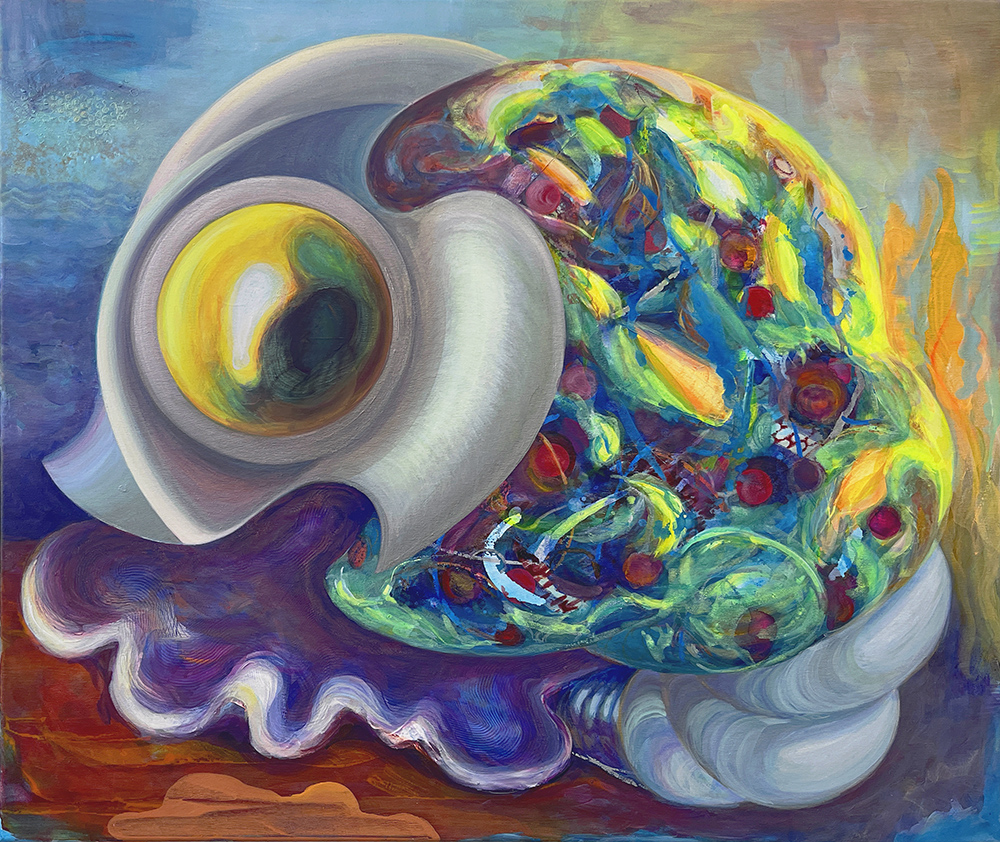
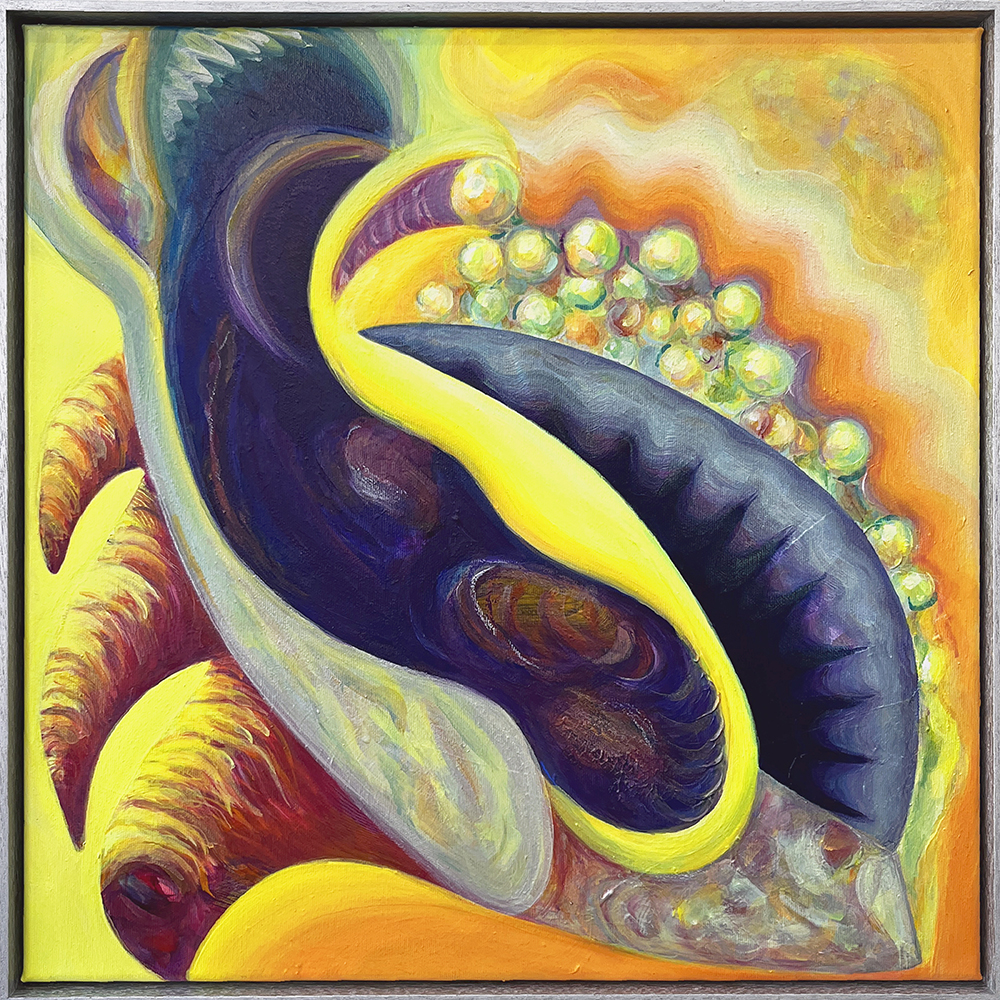
-Snail-Dreams-4_2025-布面丙烯、马克笔、粉笔、油画棒-acrylic-marker-pastel-oil-pastel-on-canvas-80x60-cm.jpg)
-Snail-Dreams-1_2024-布面丙烯、马克笔、油画棒-acrylic-marker-oil-pastel-on-canvas-80x60-cm.jpg)
